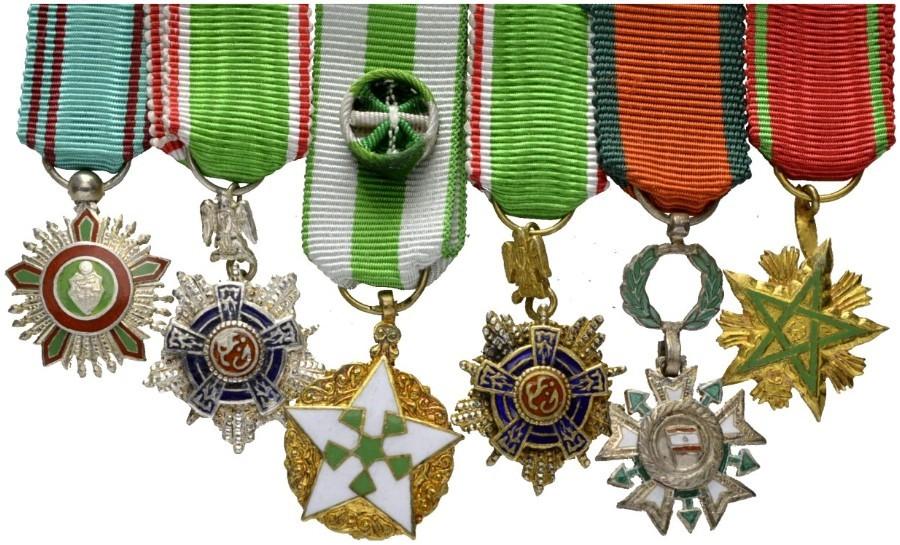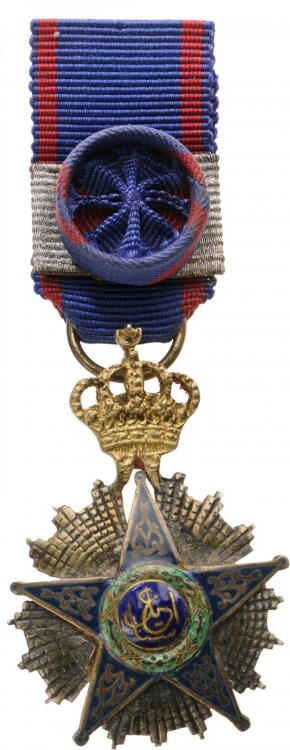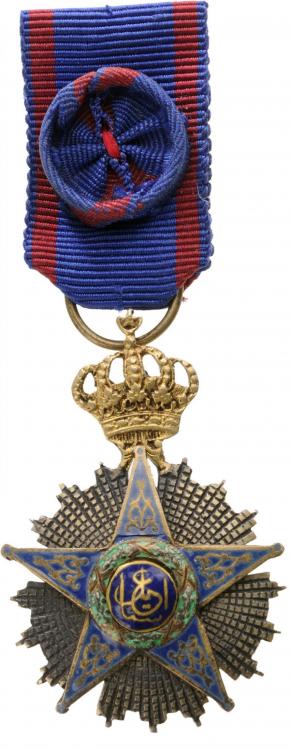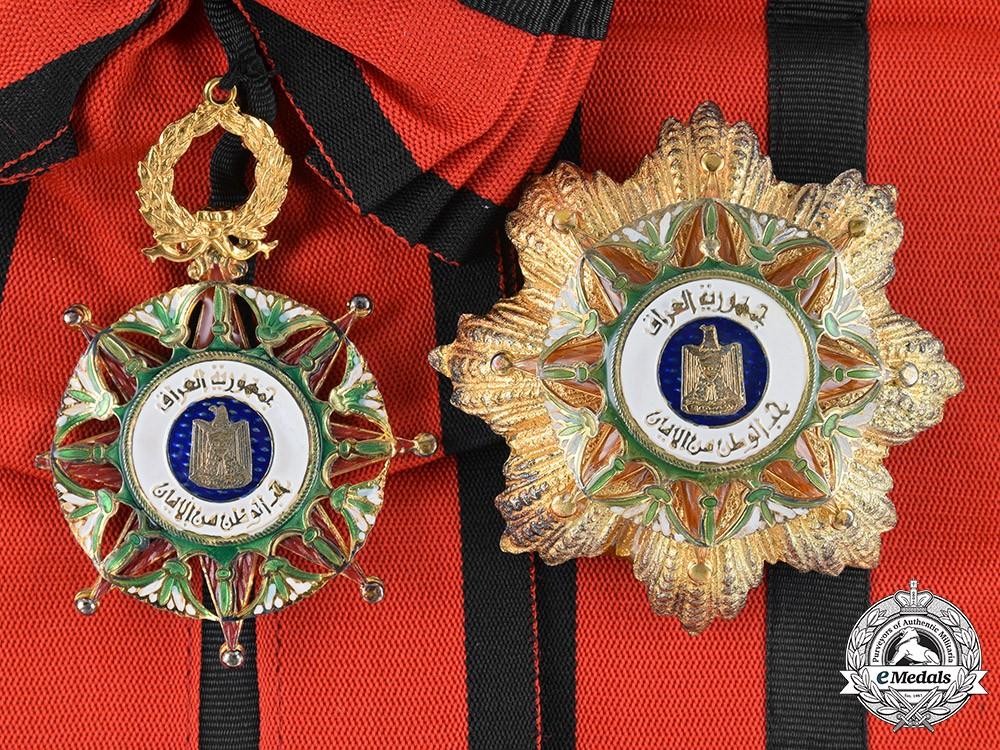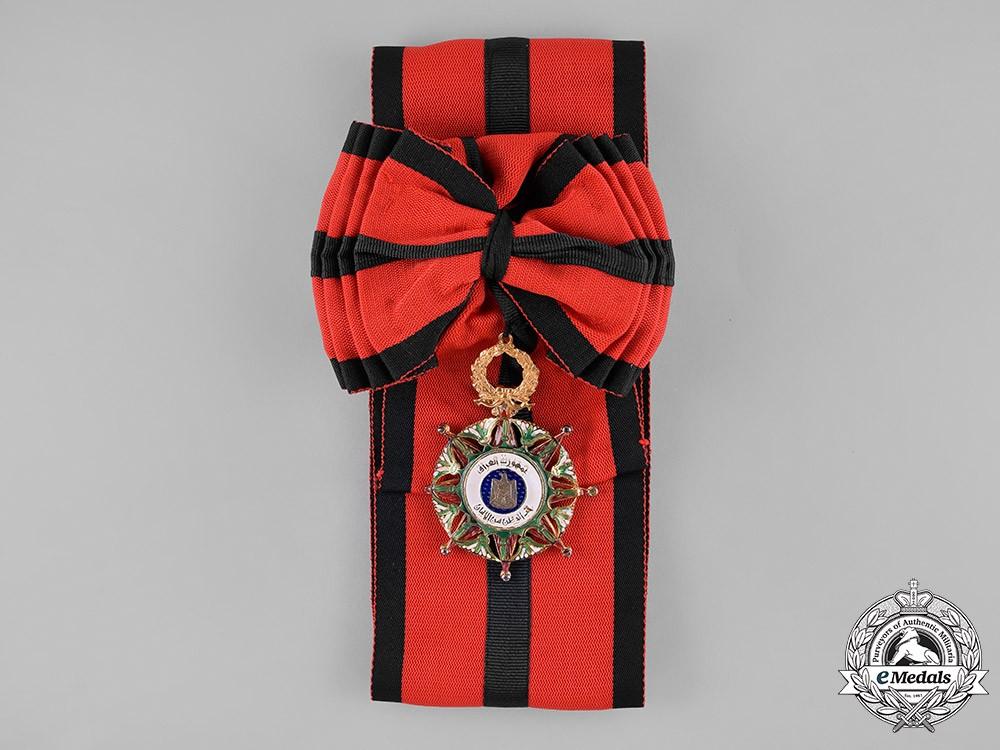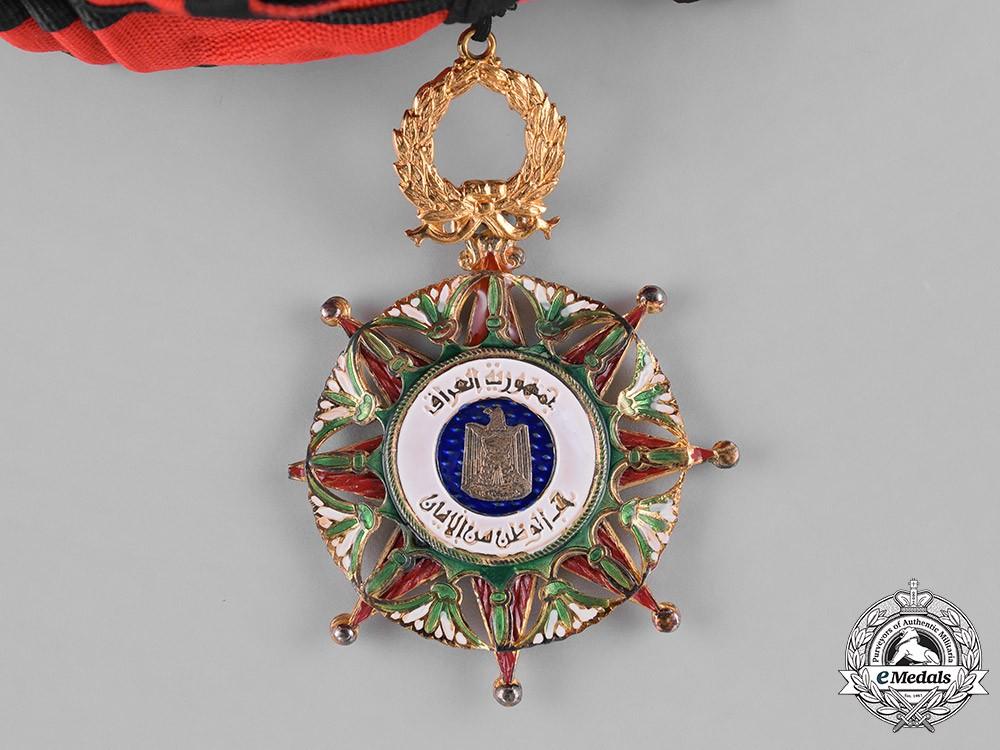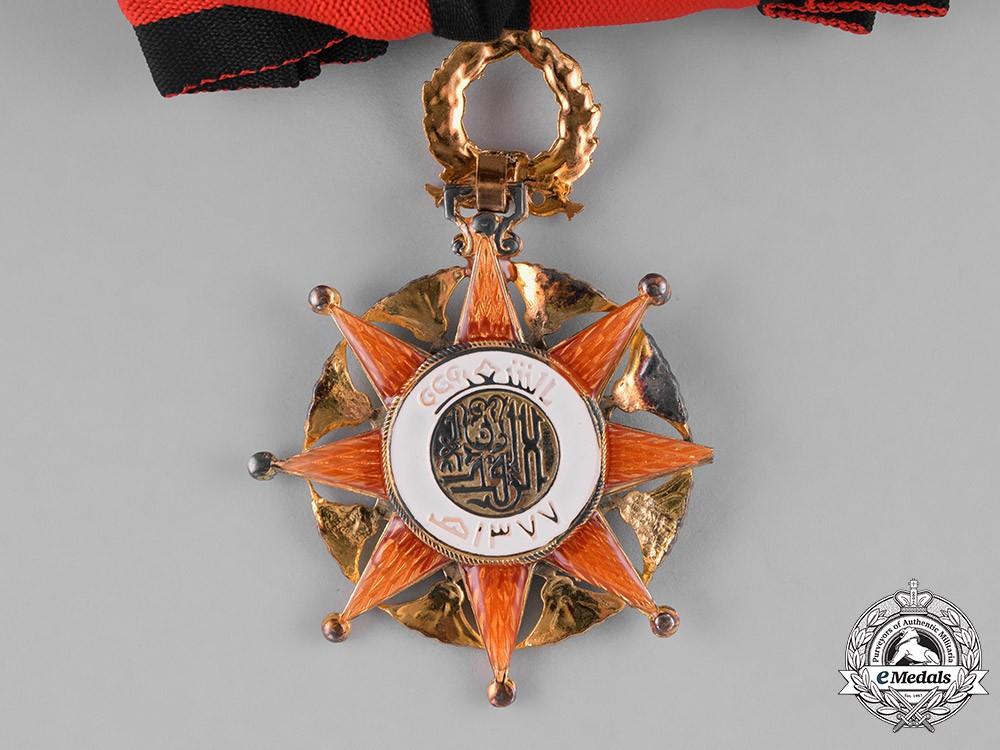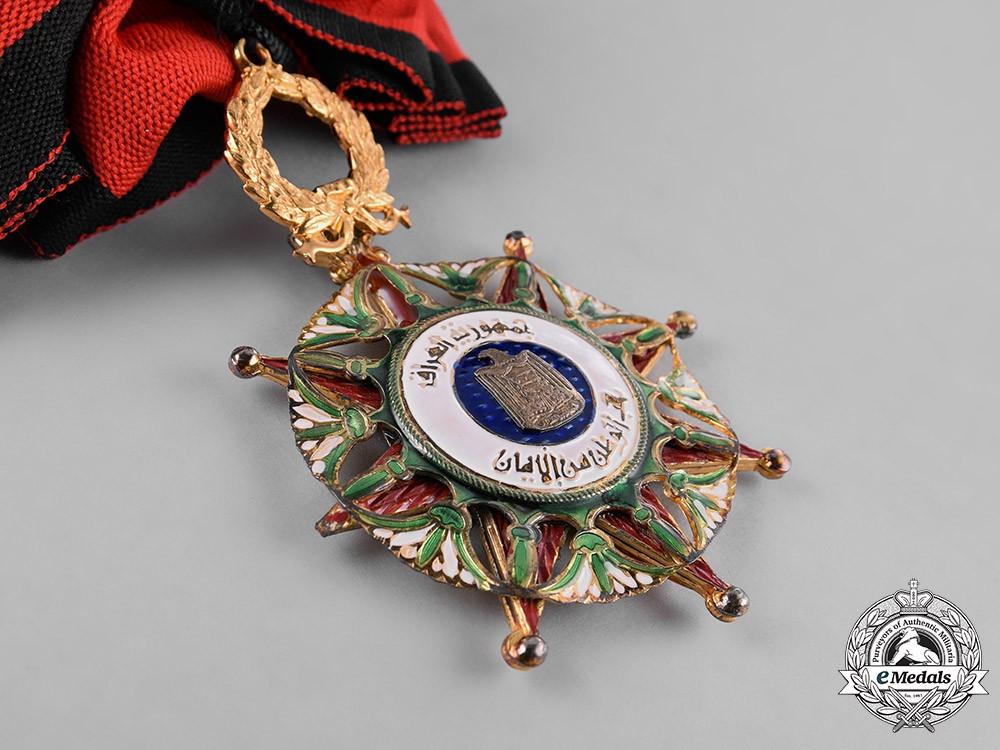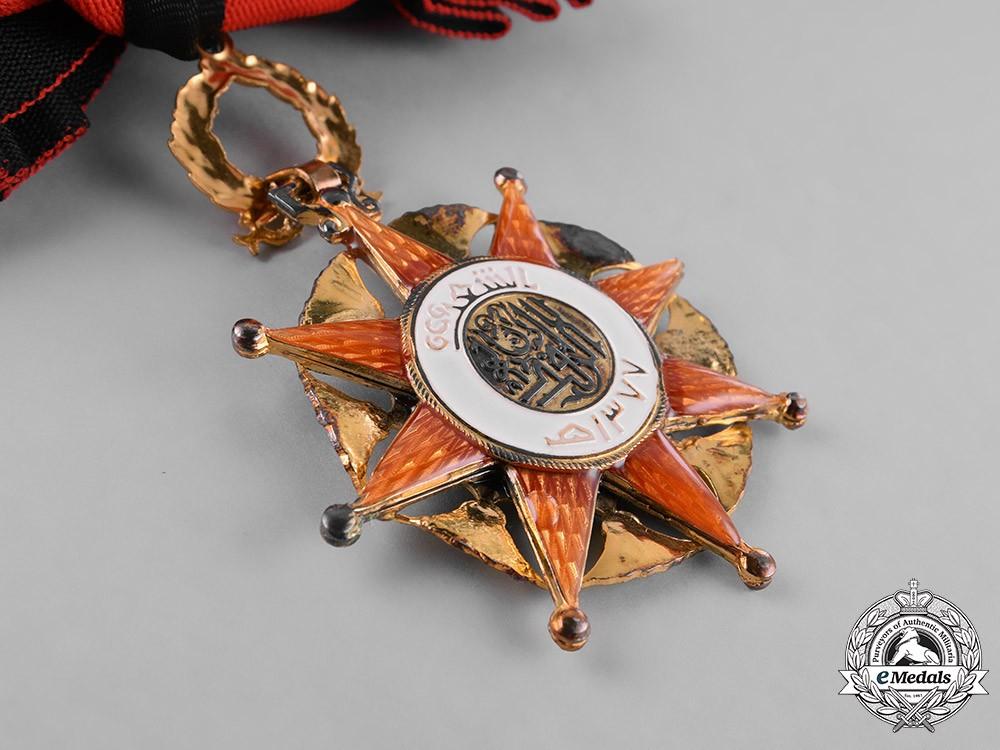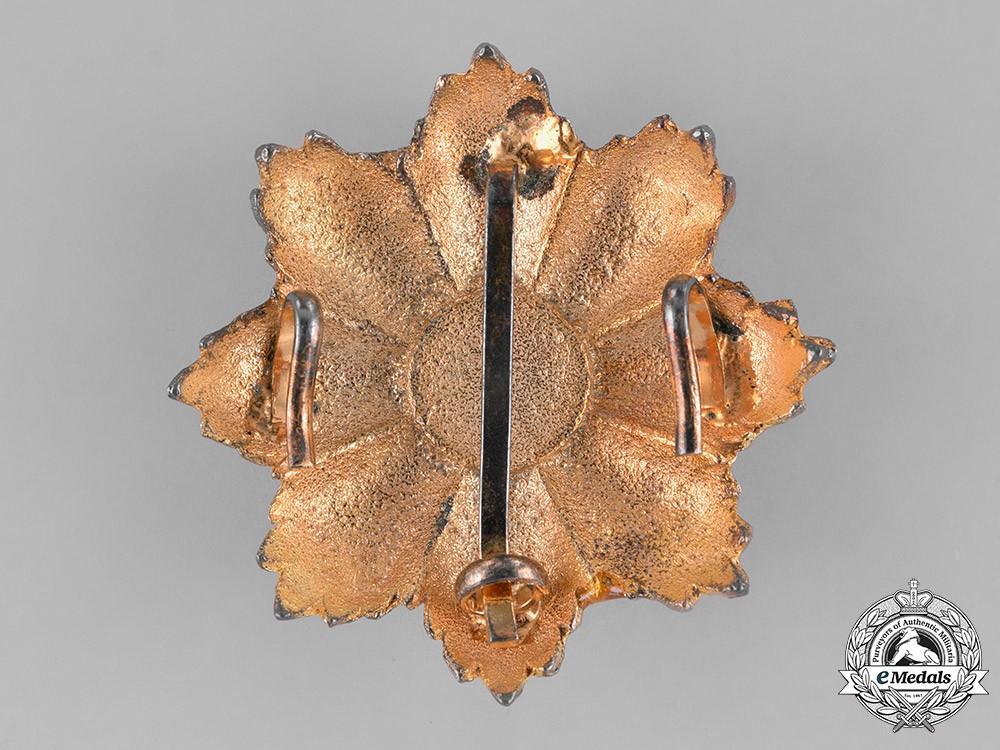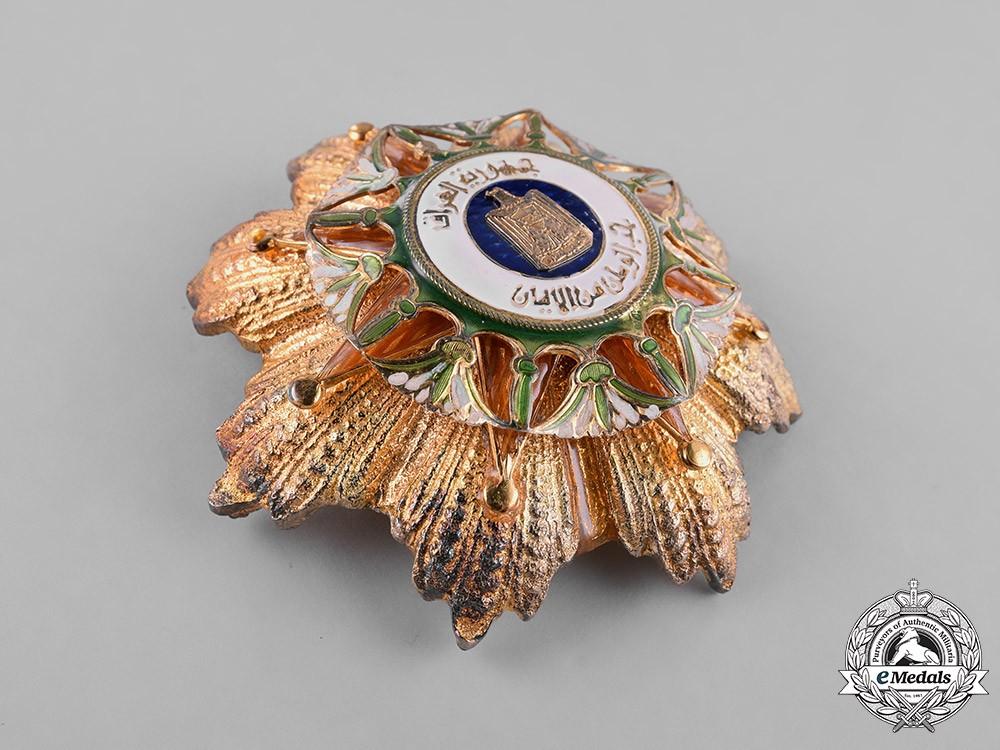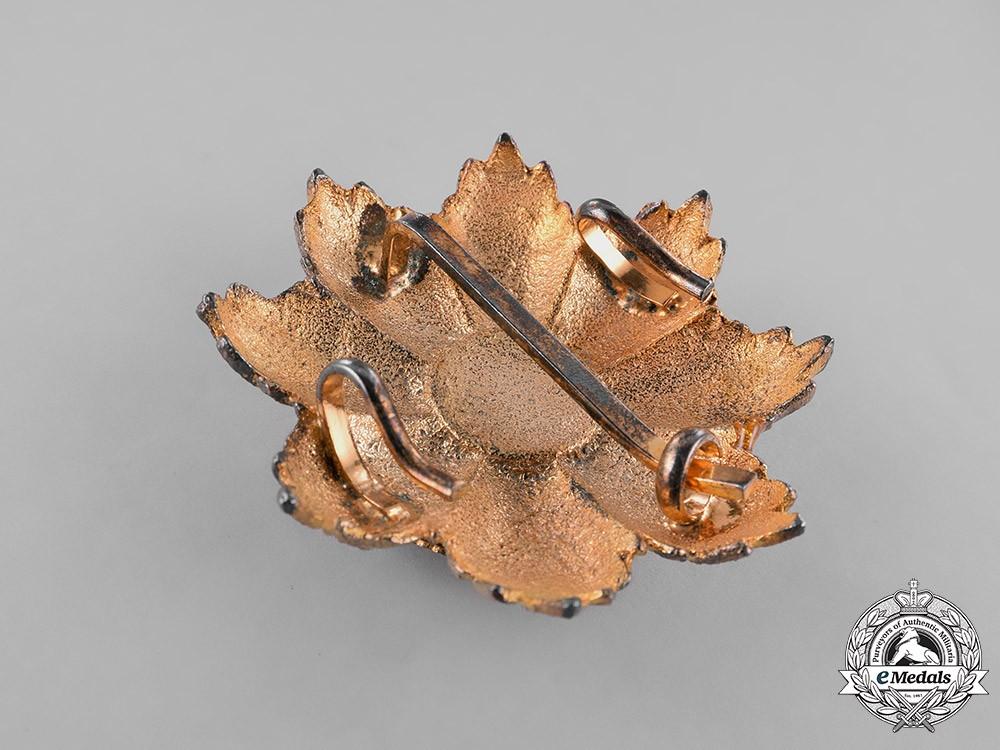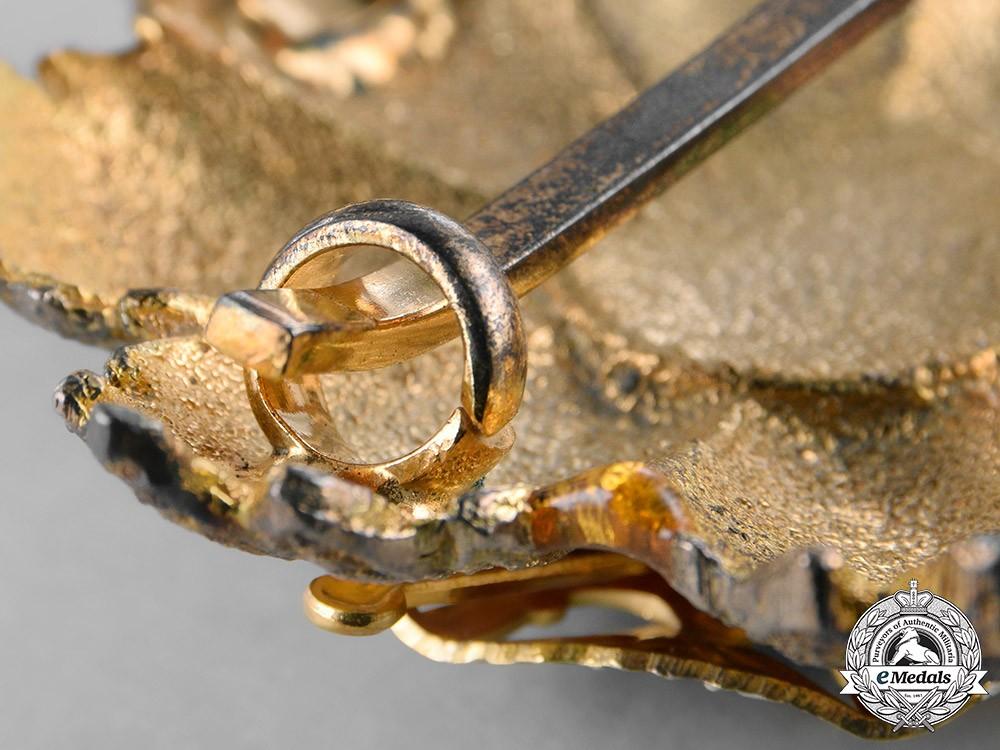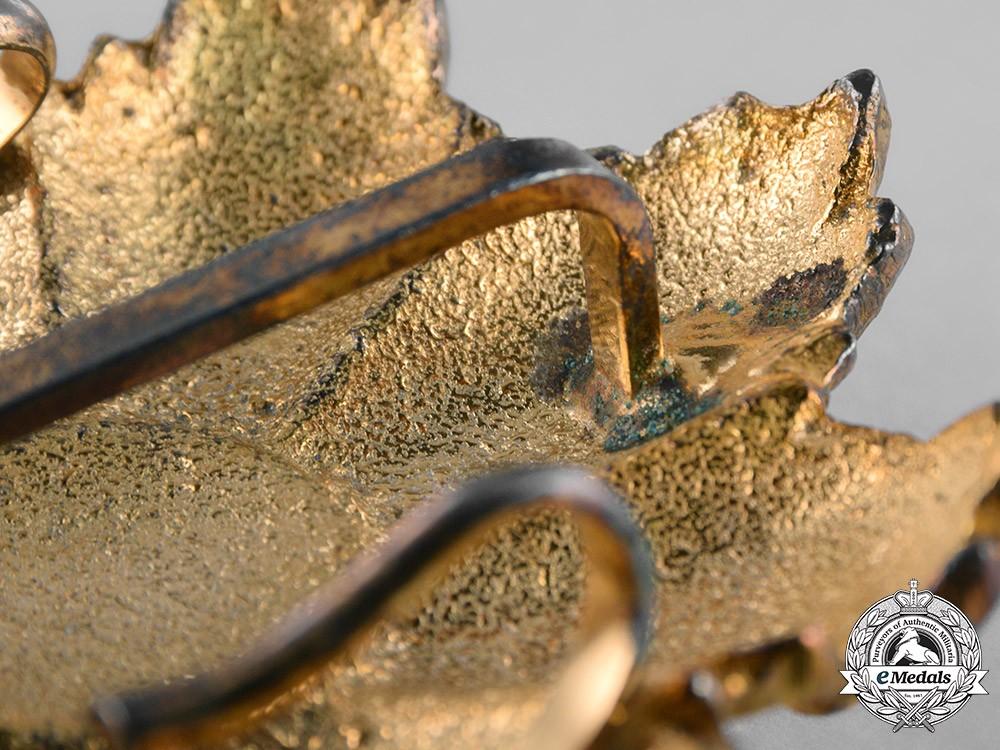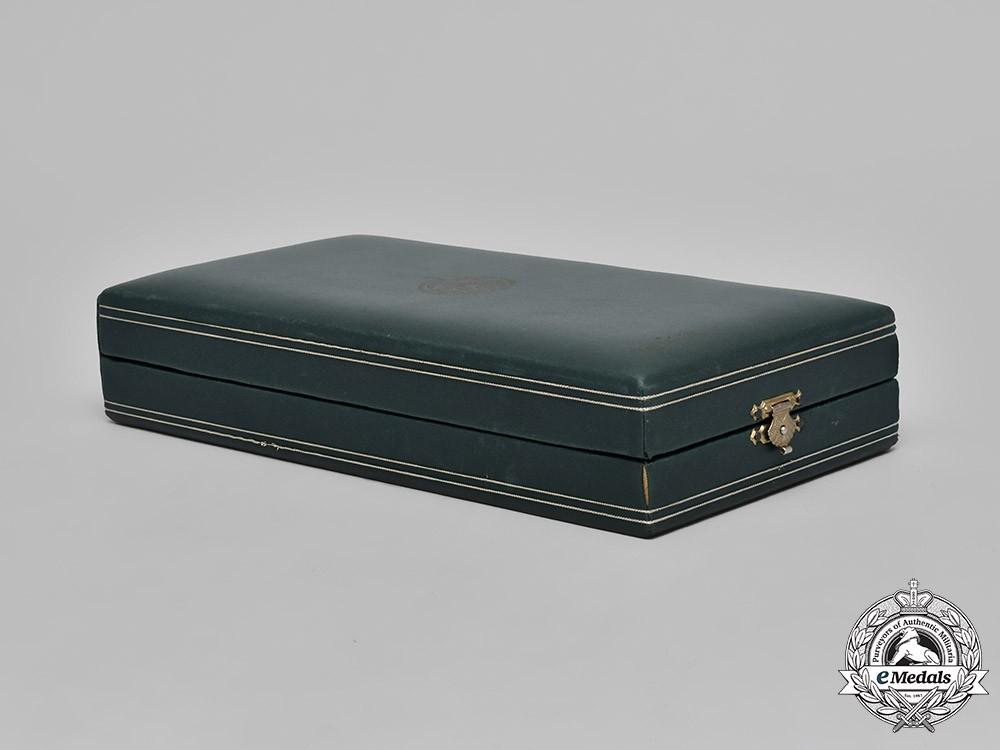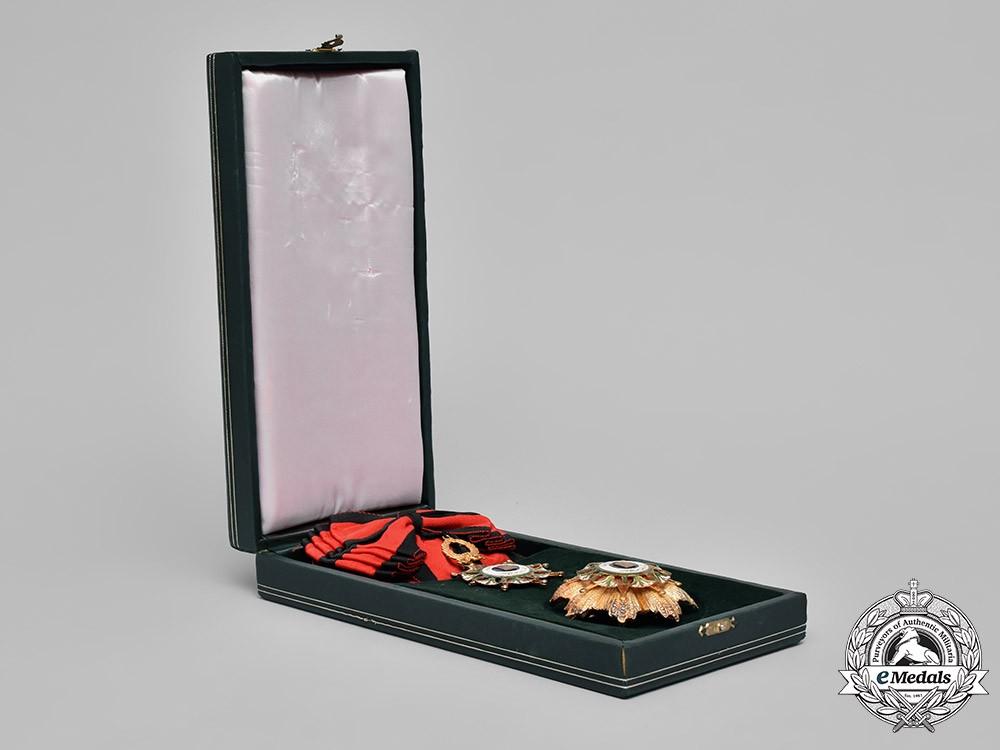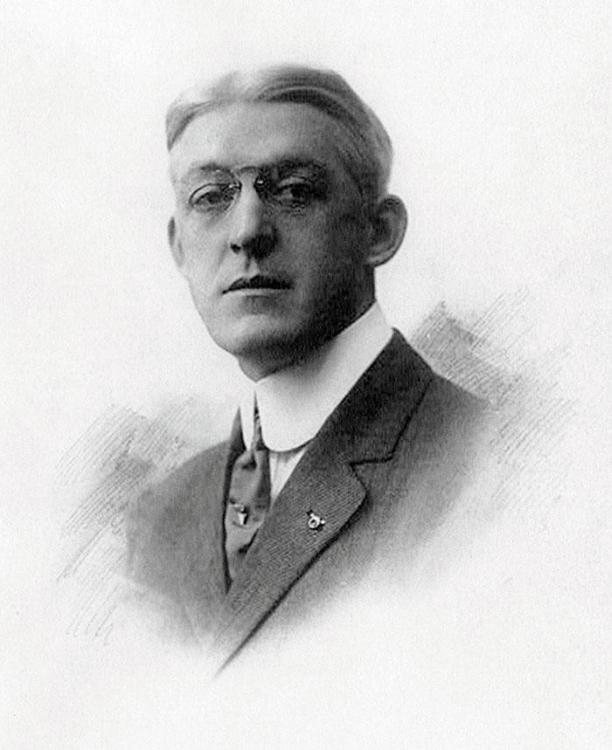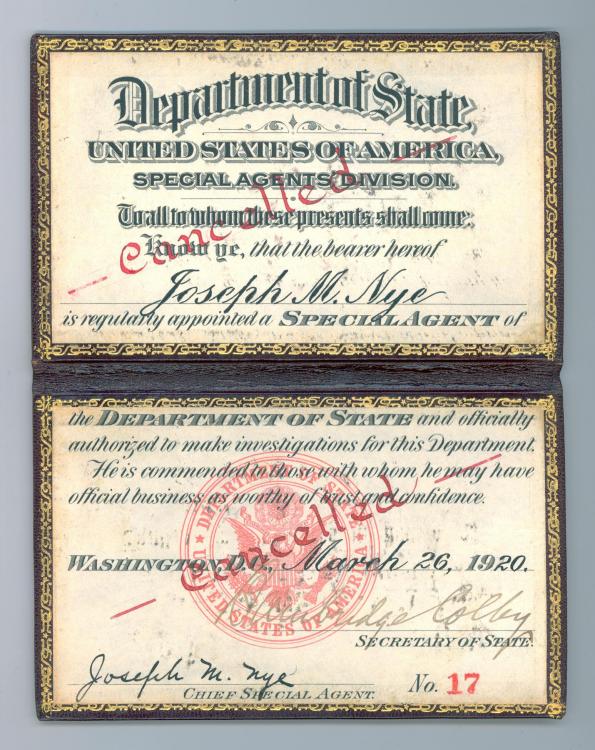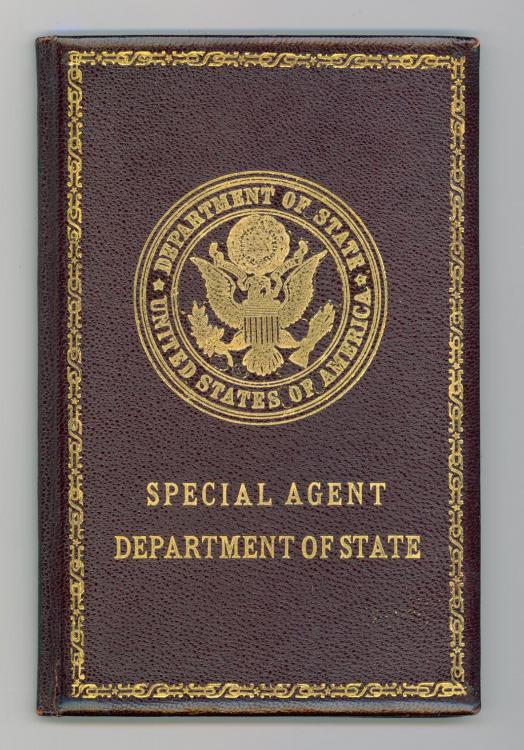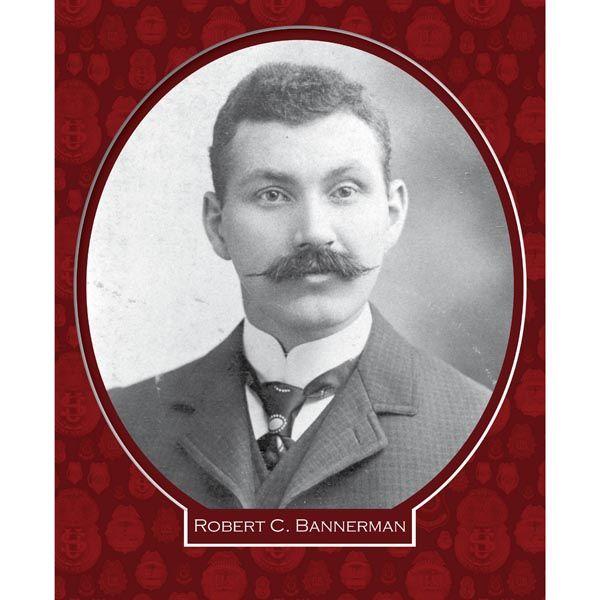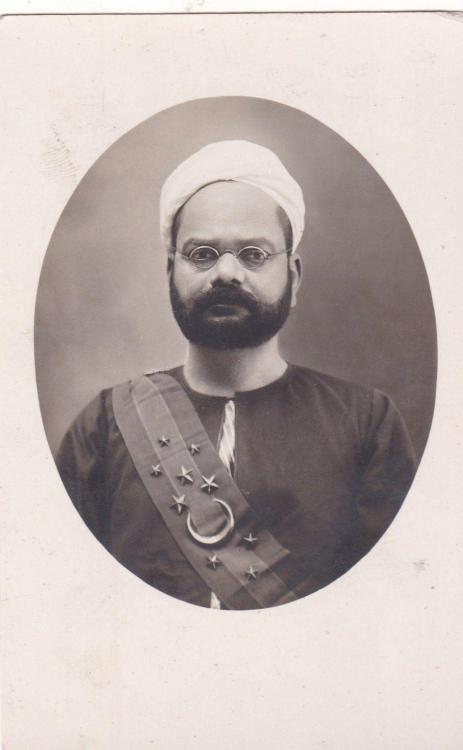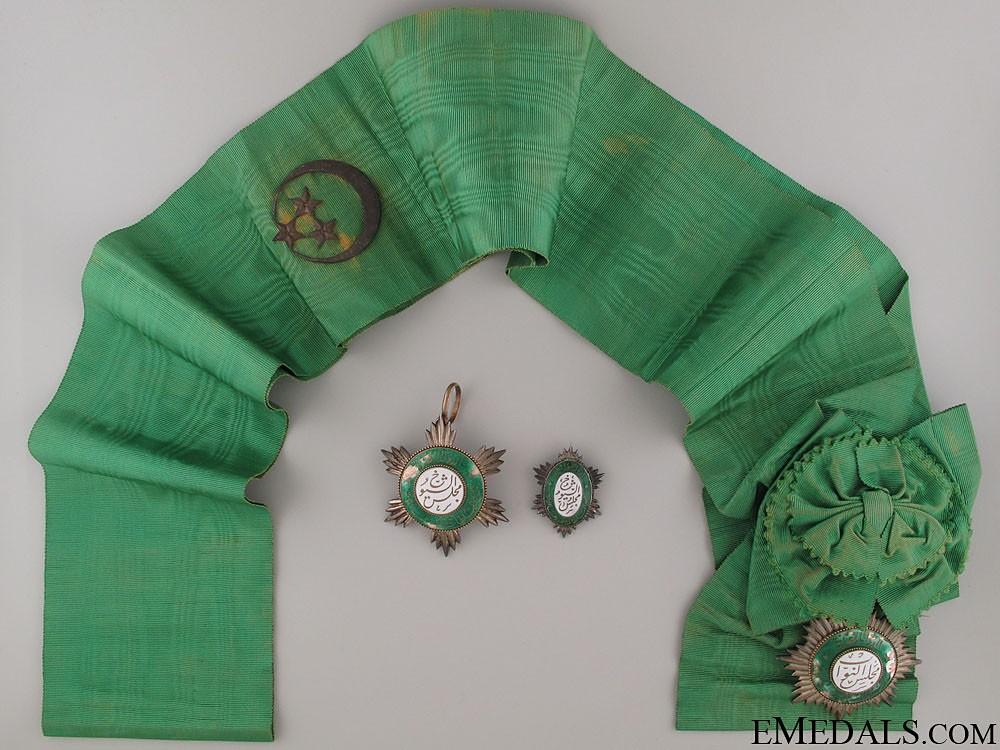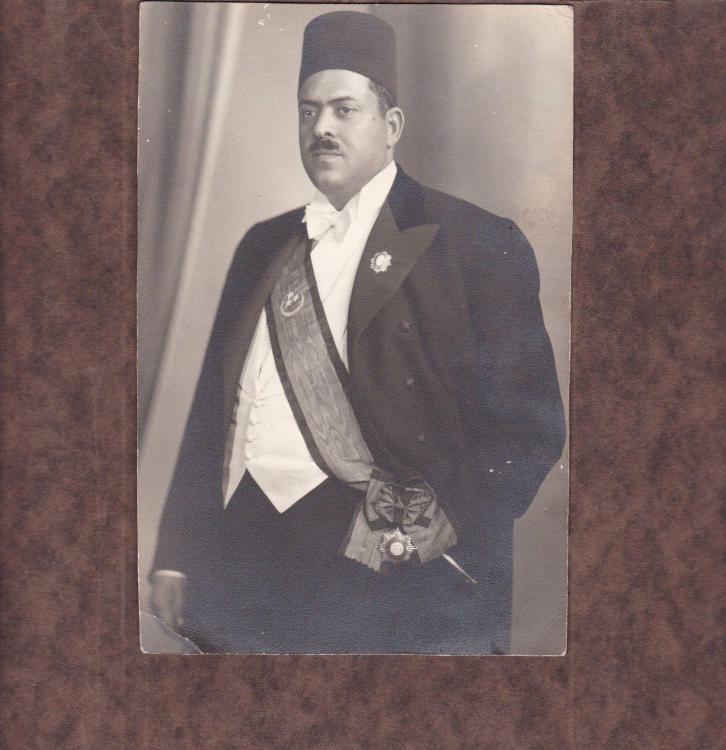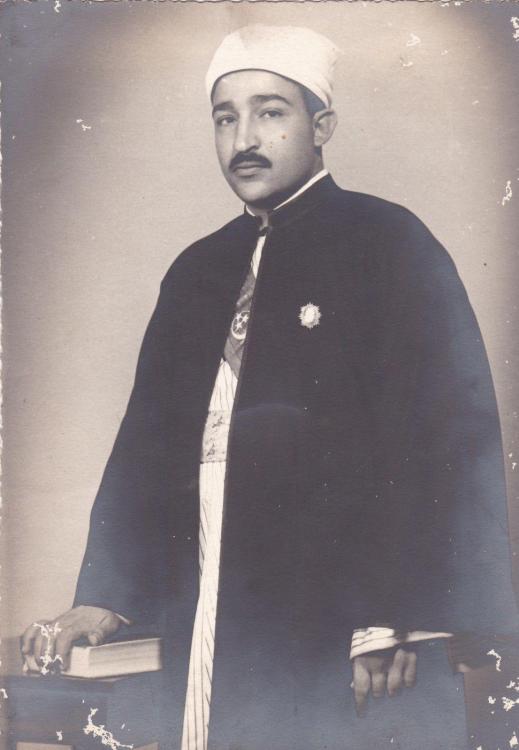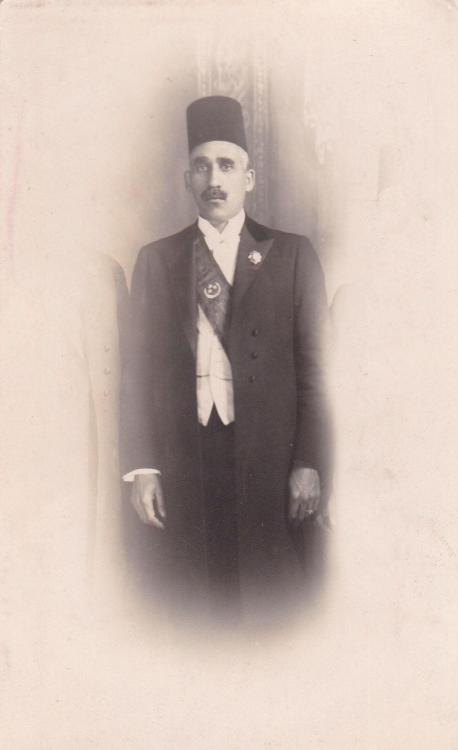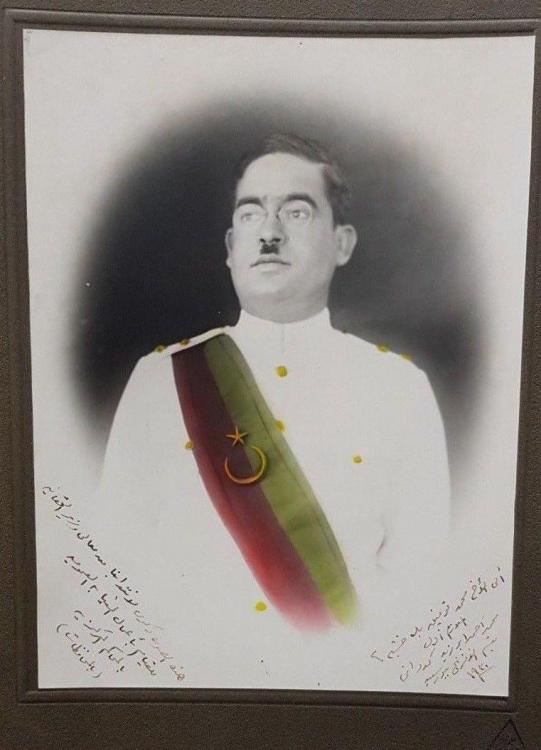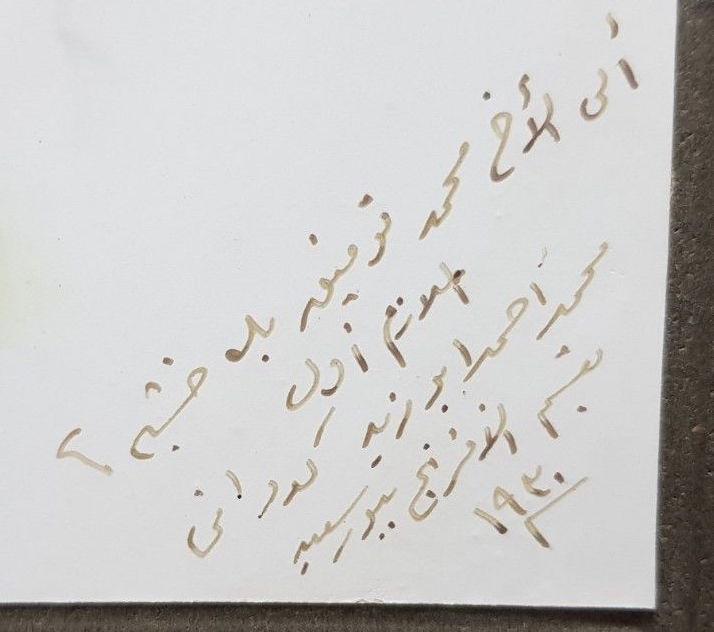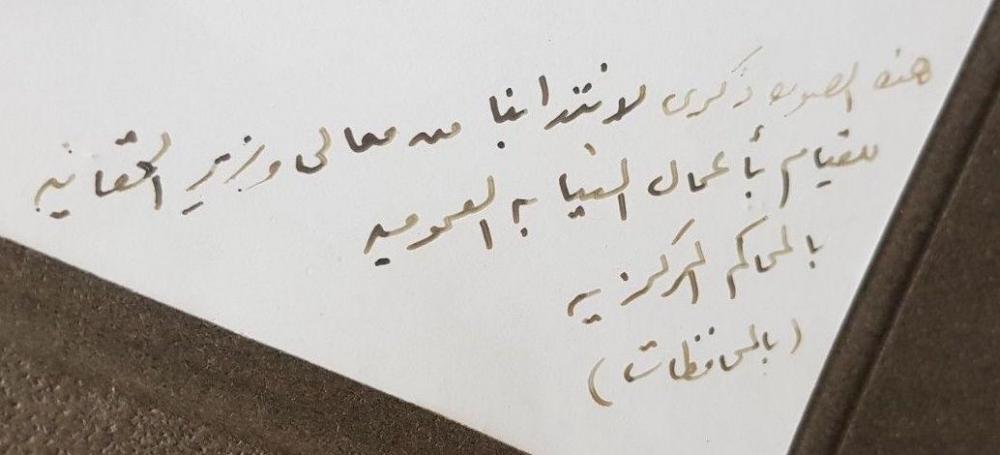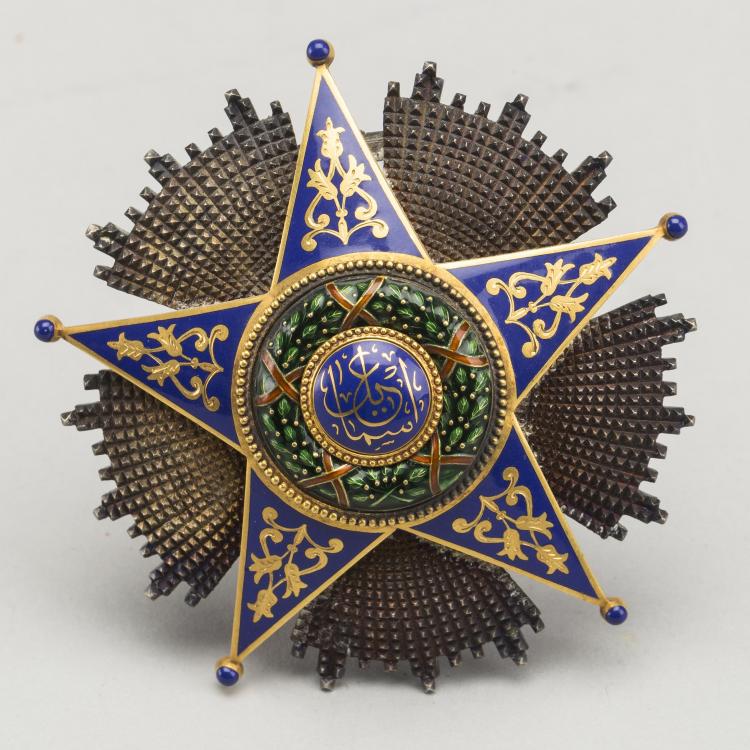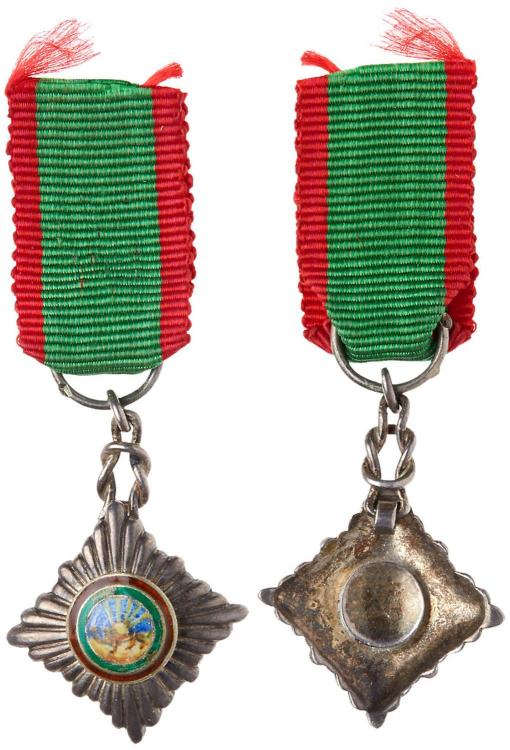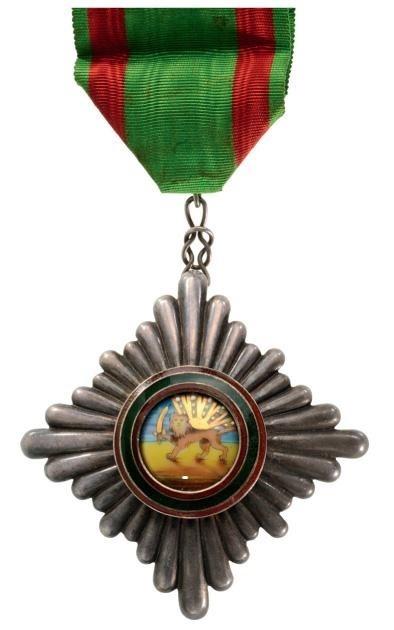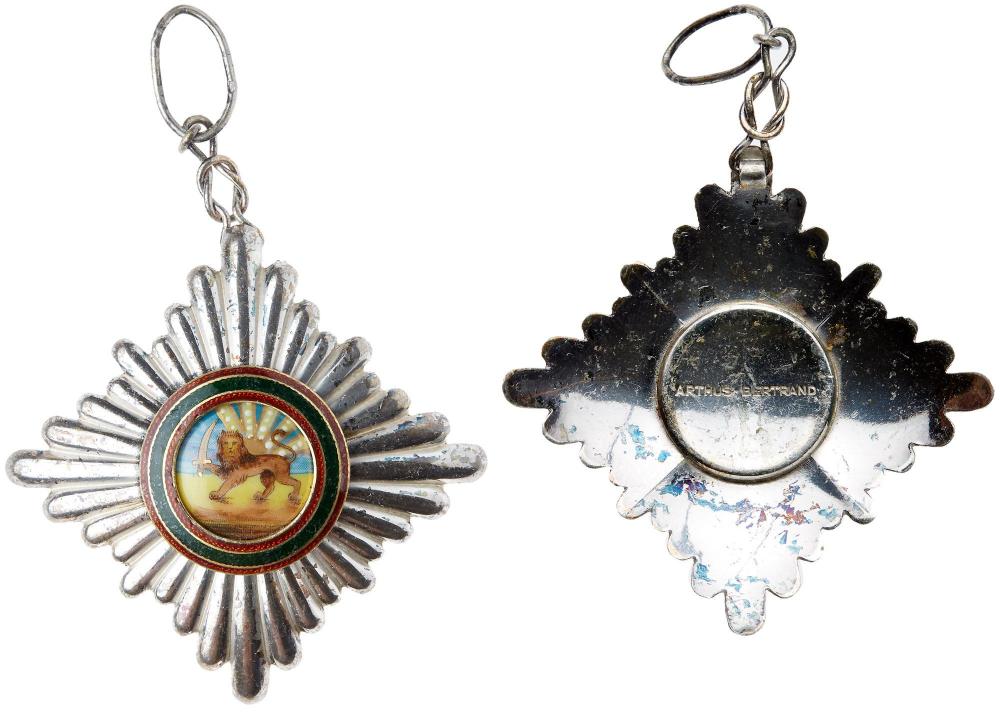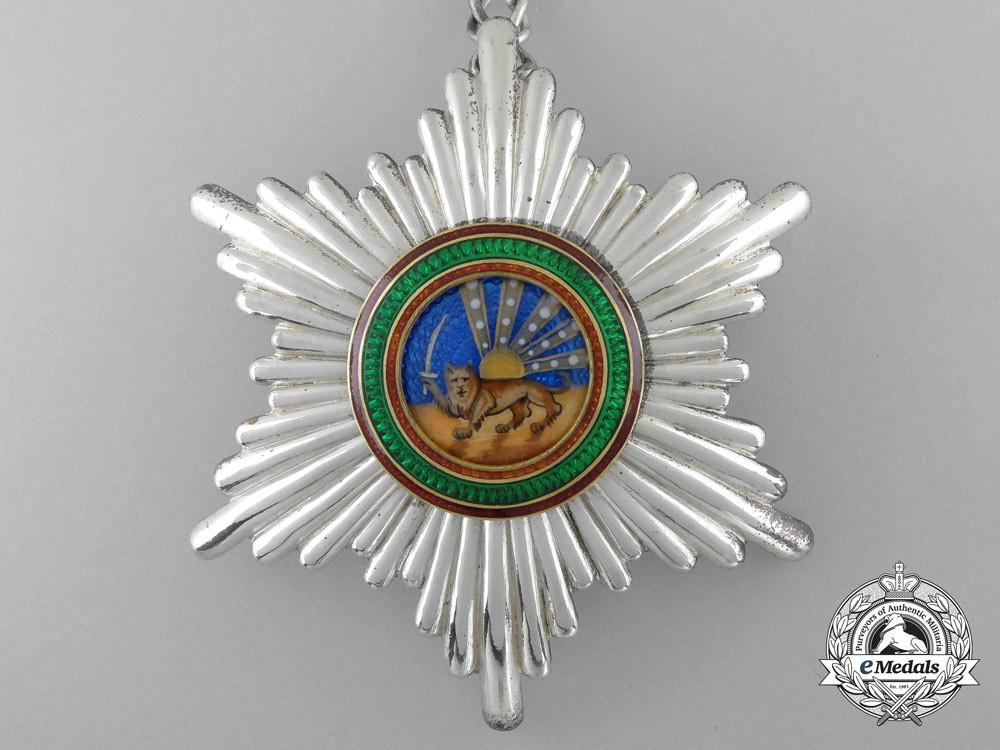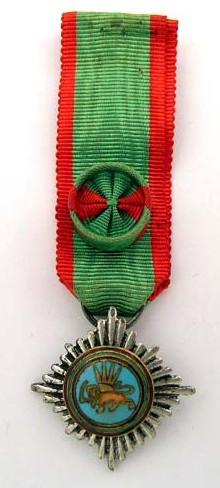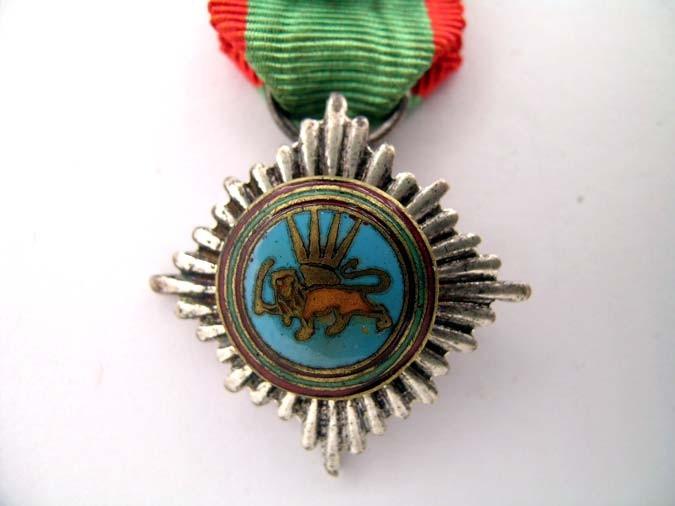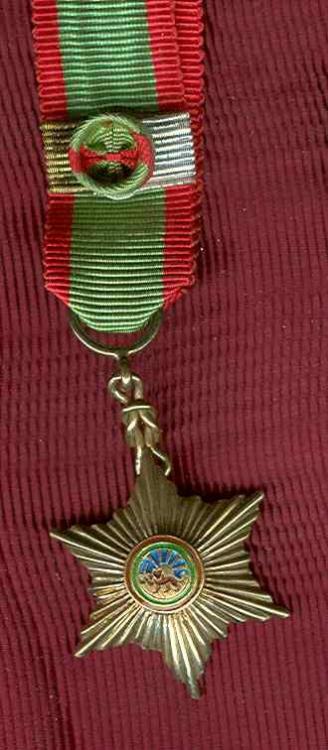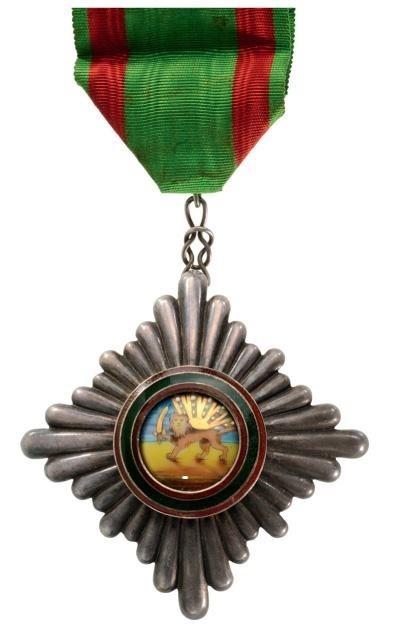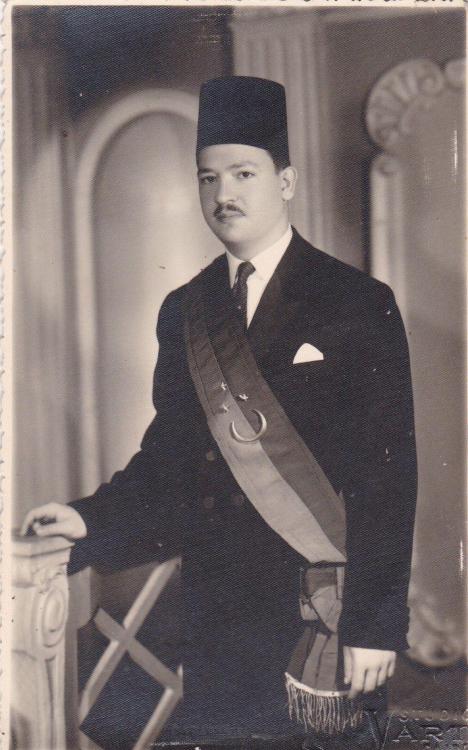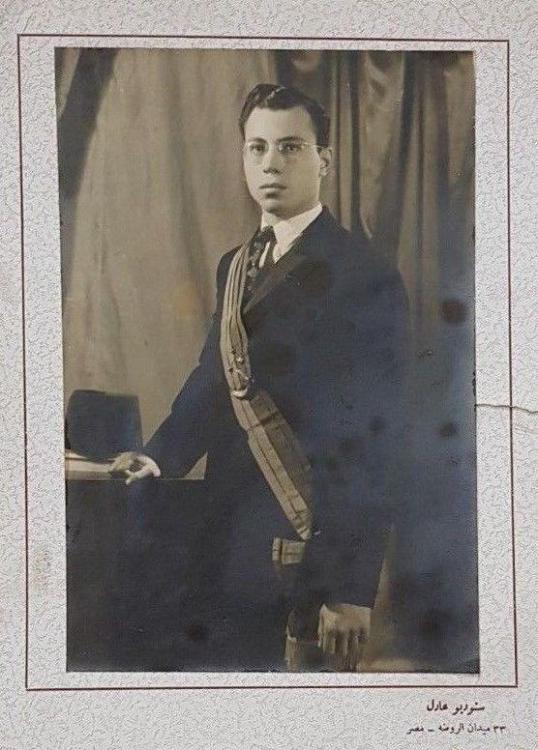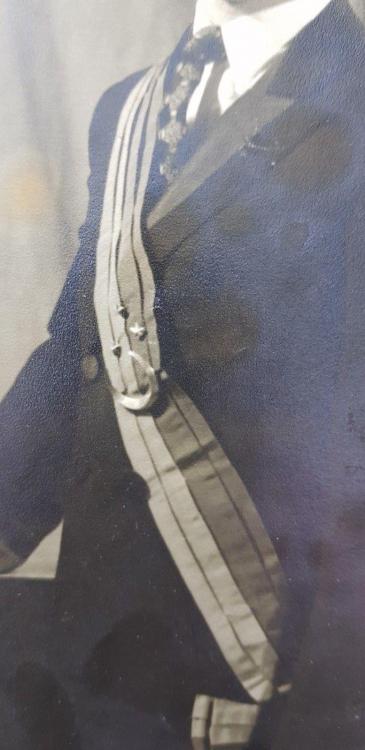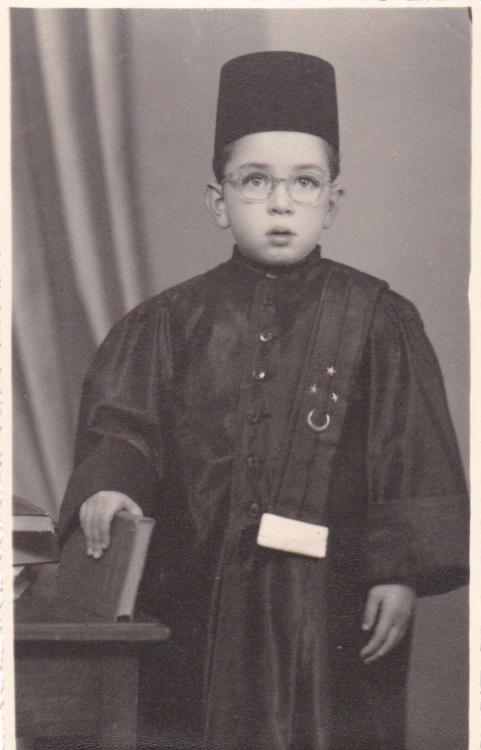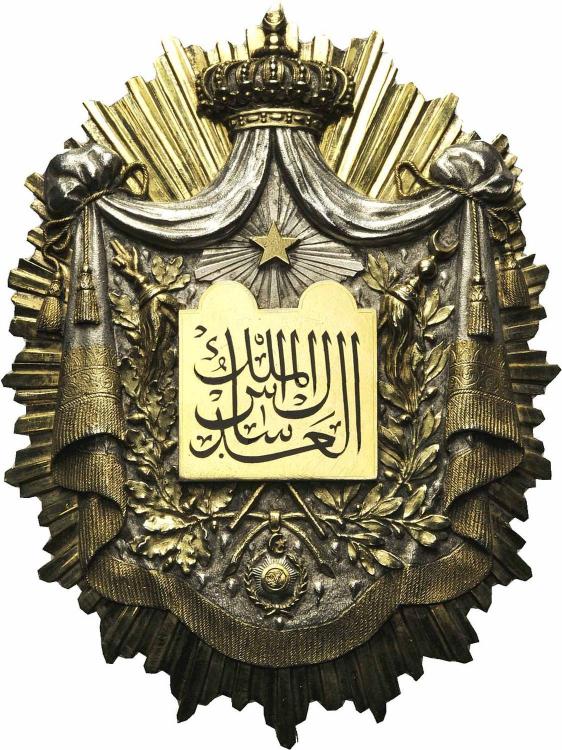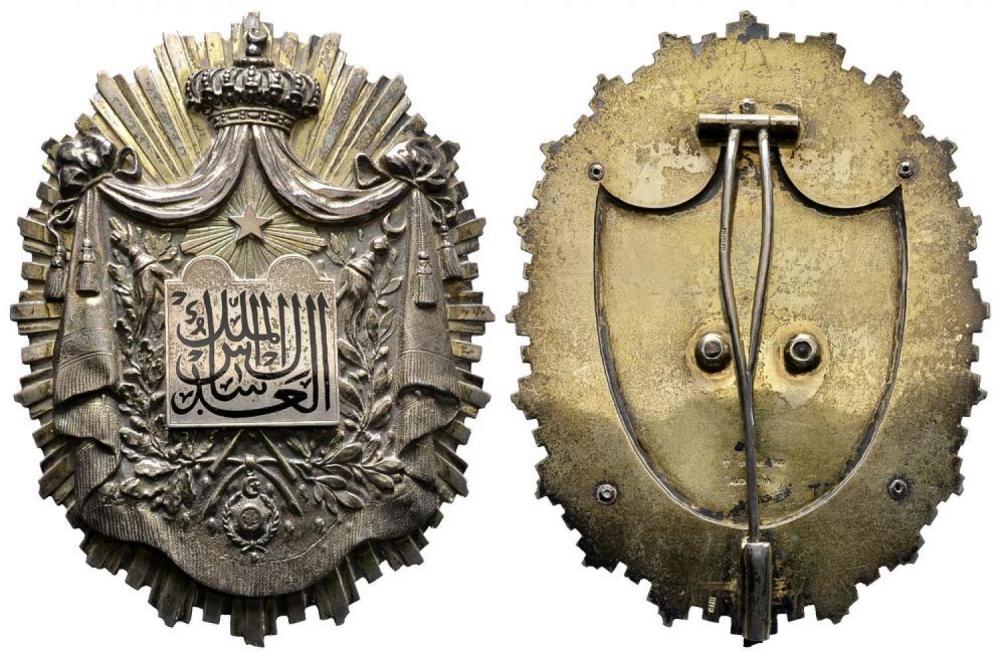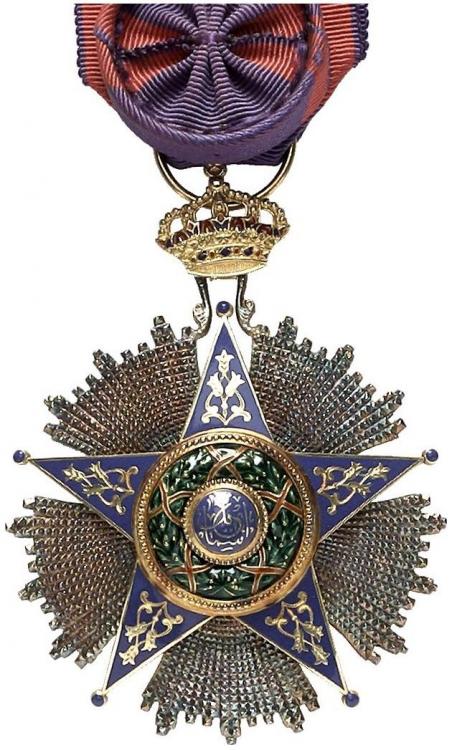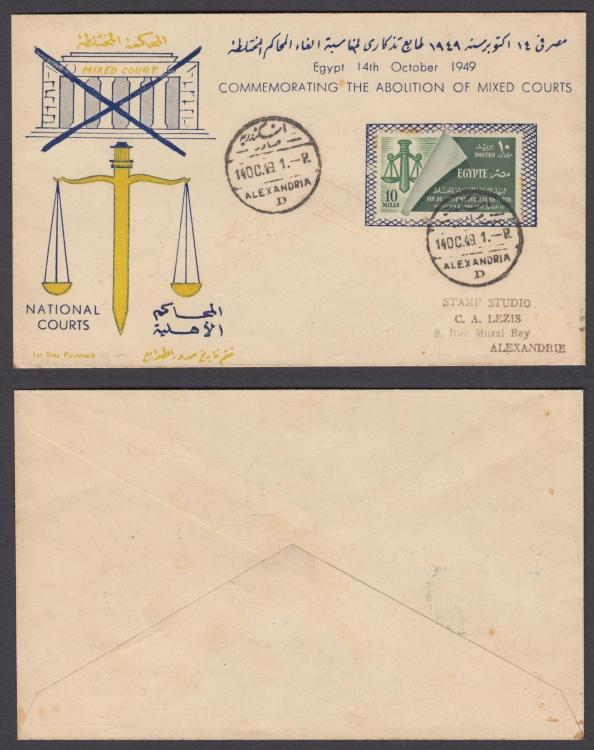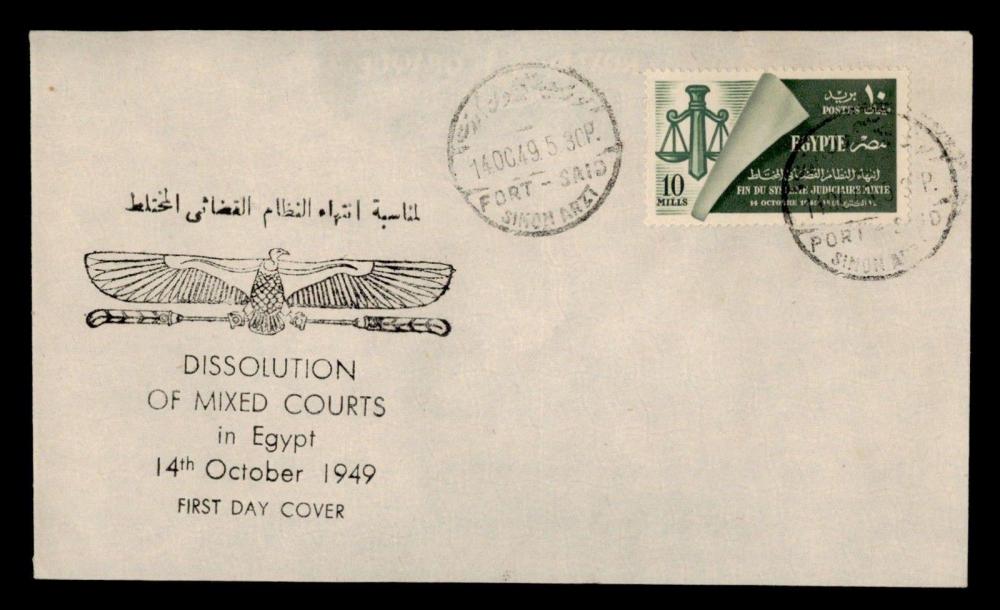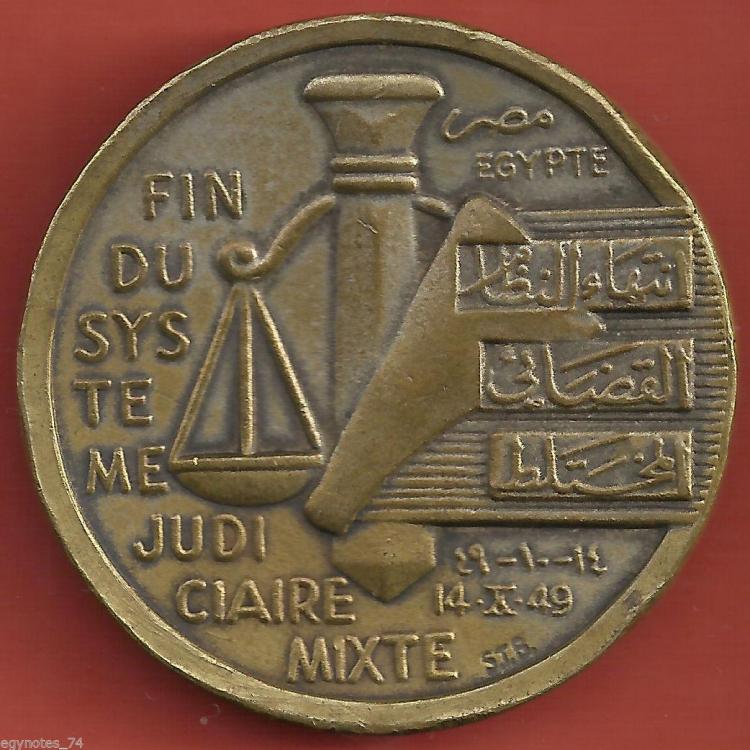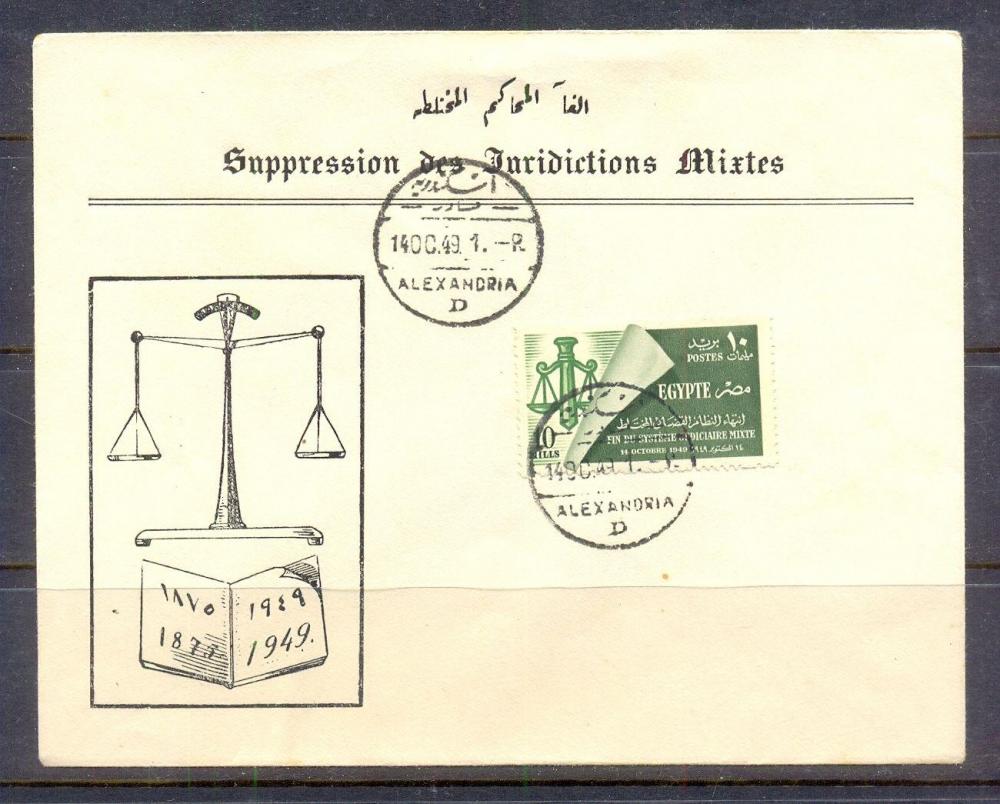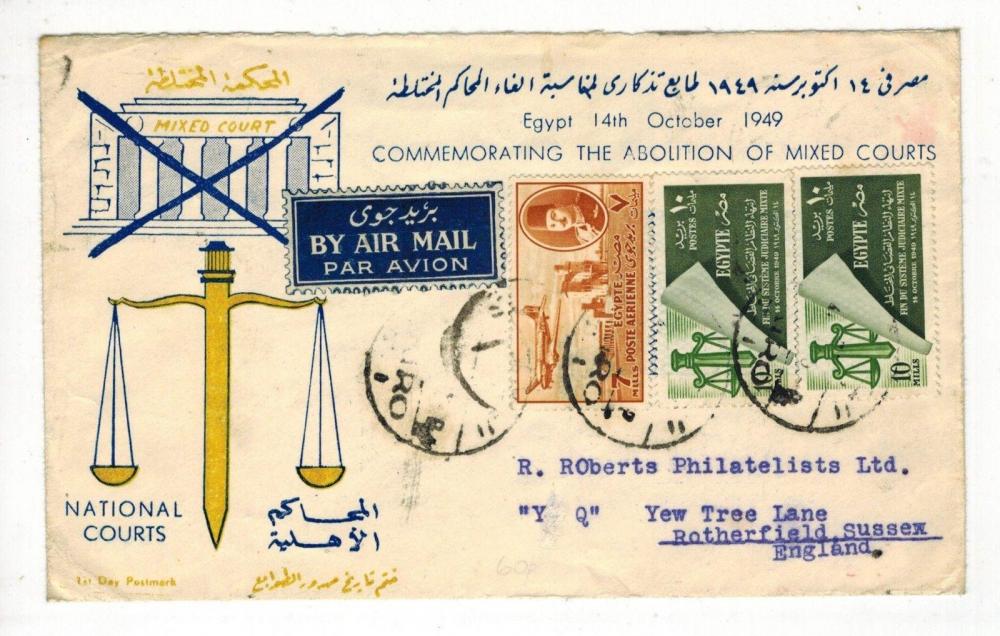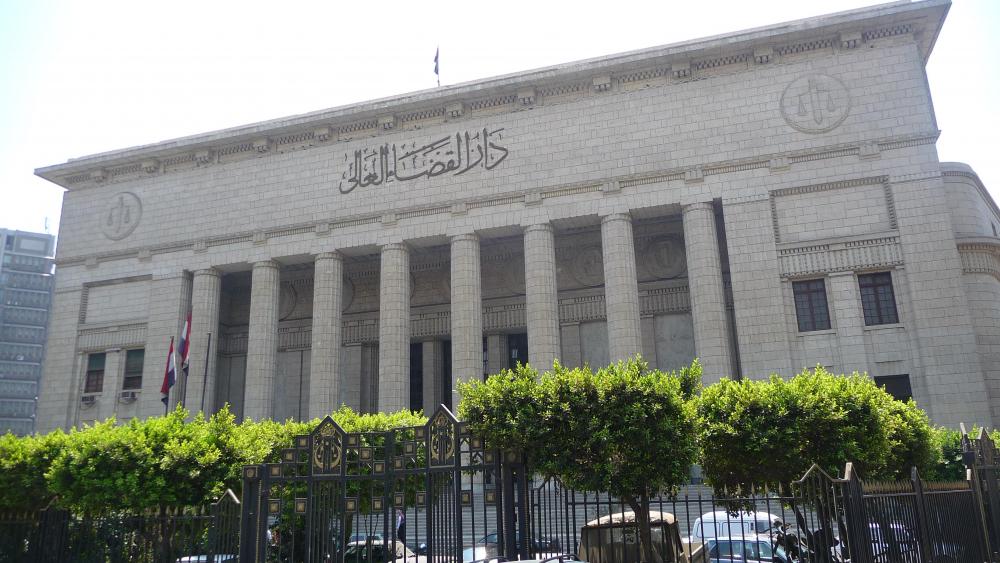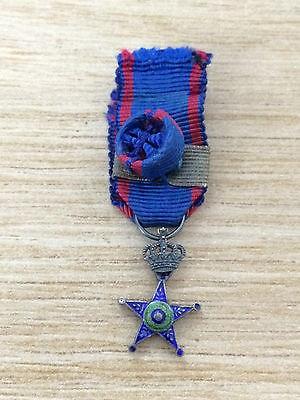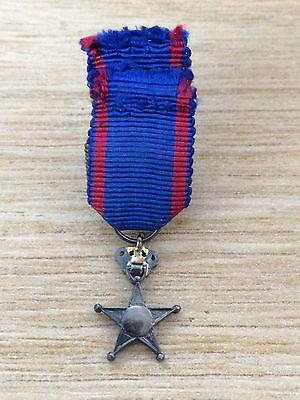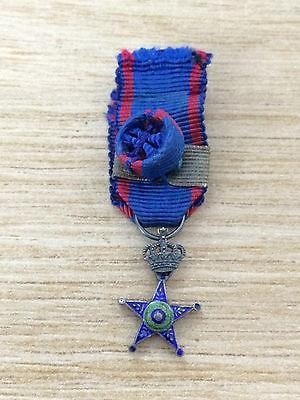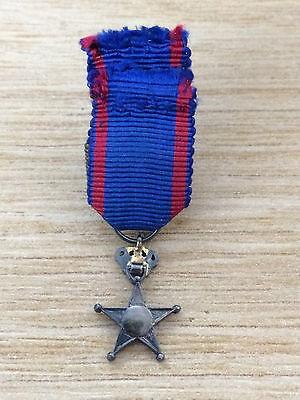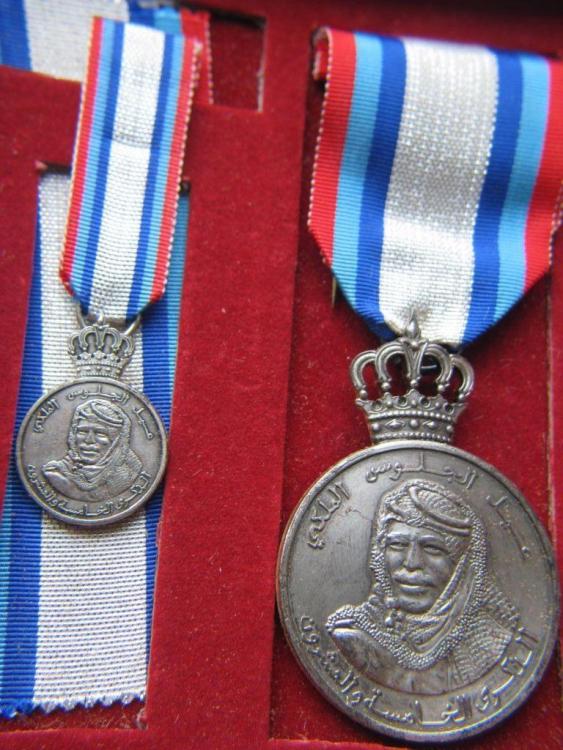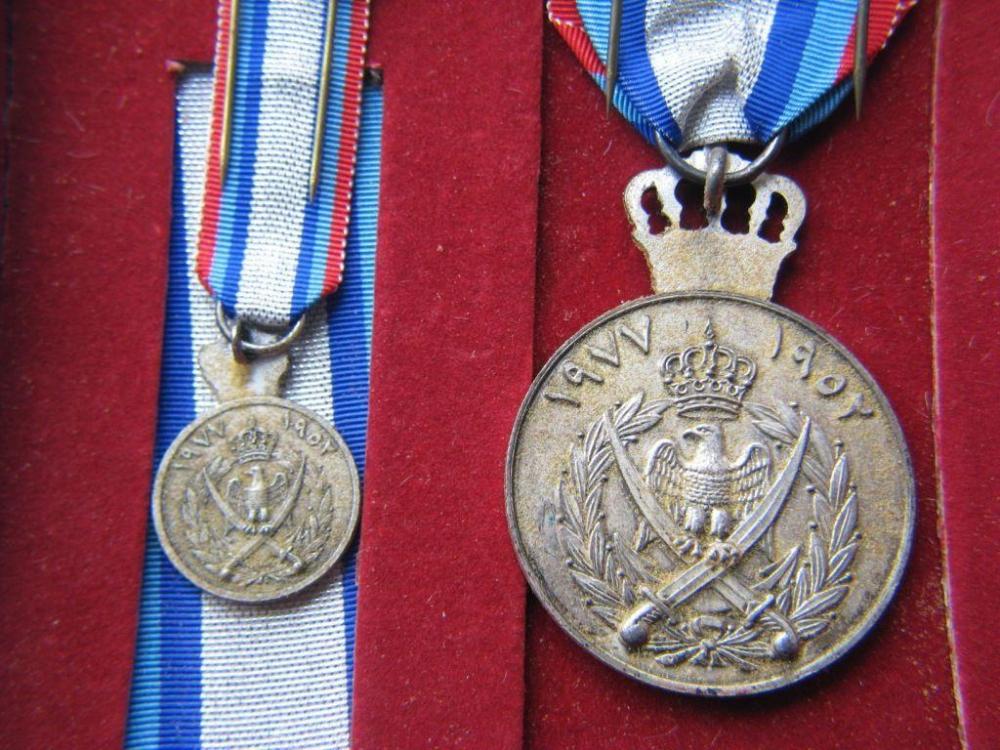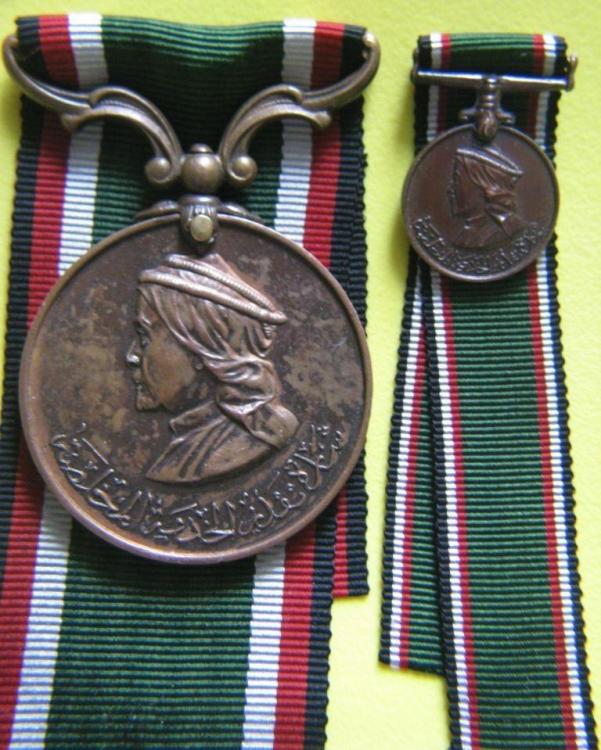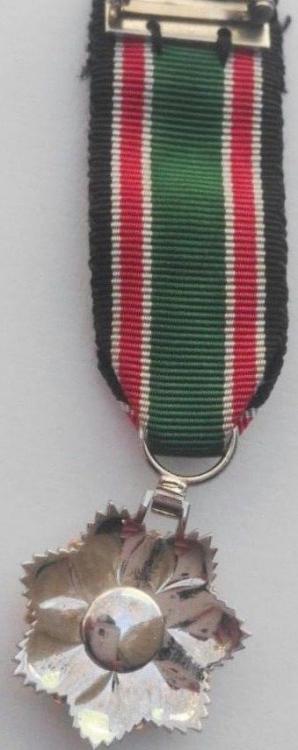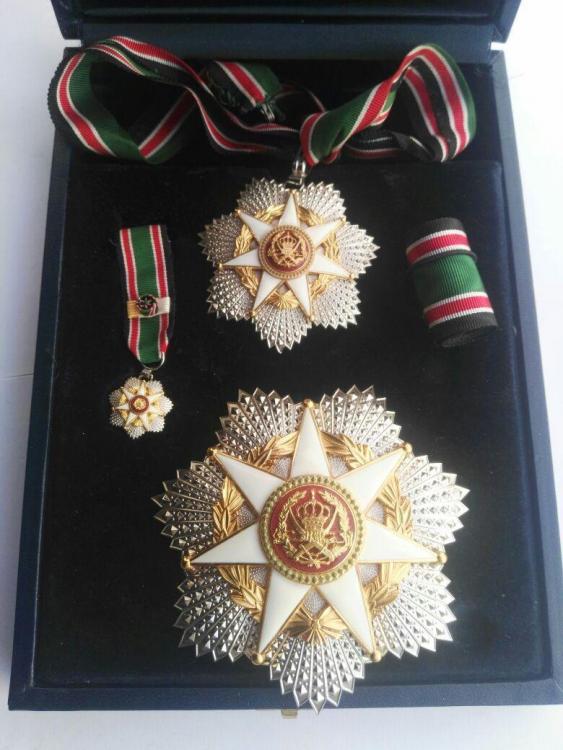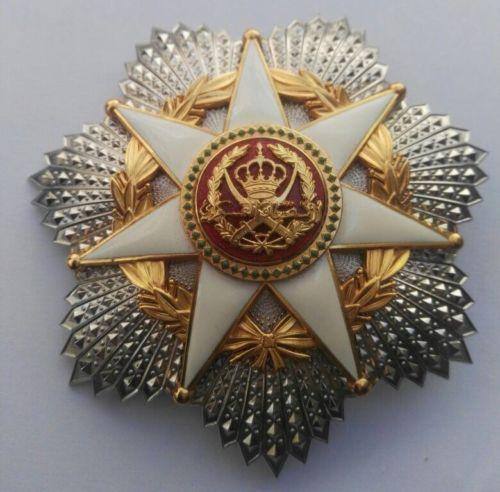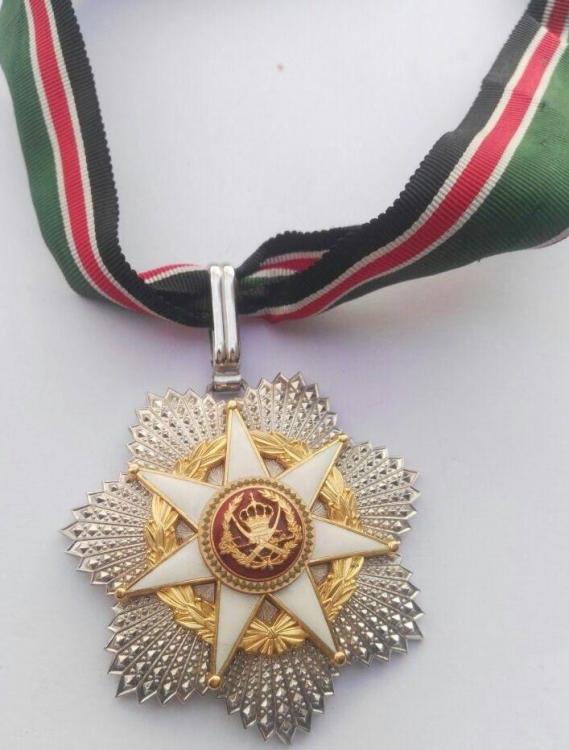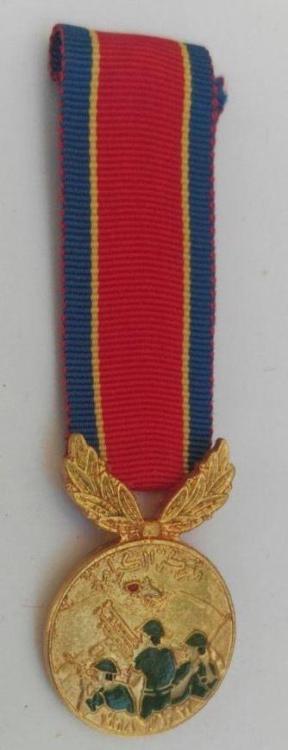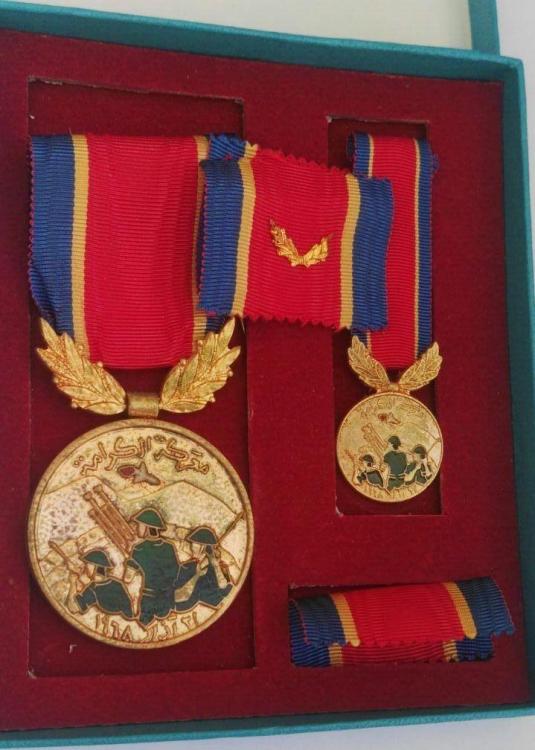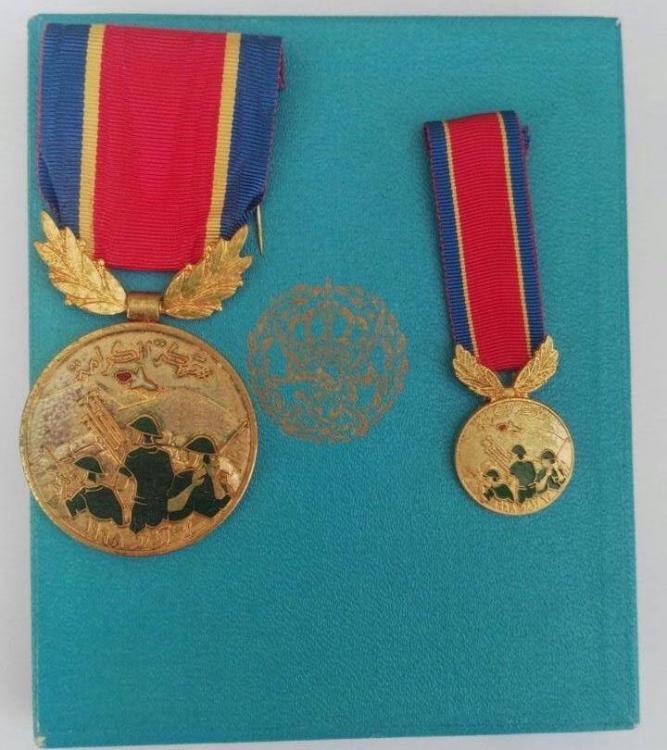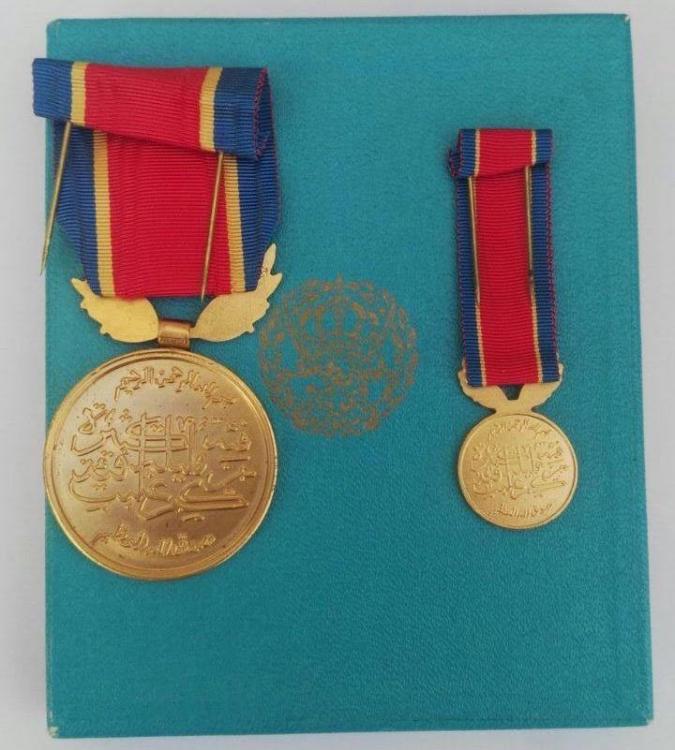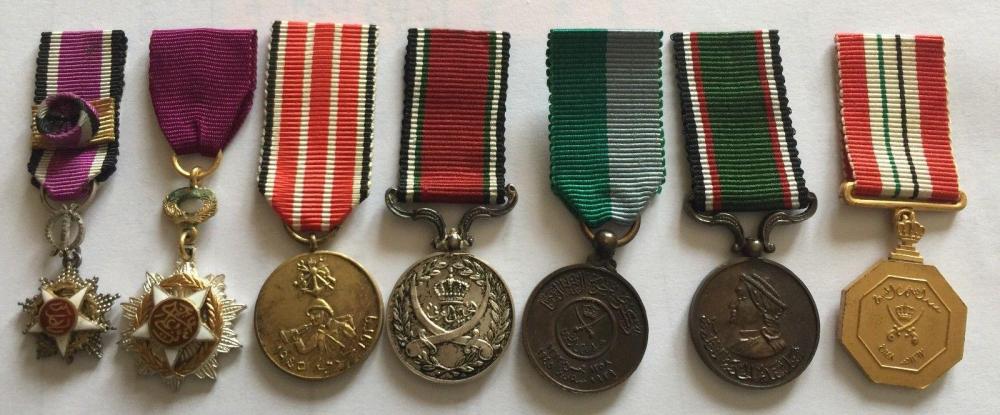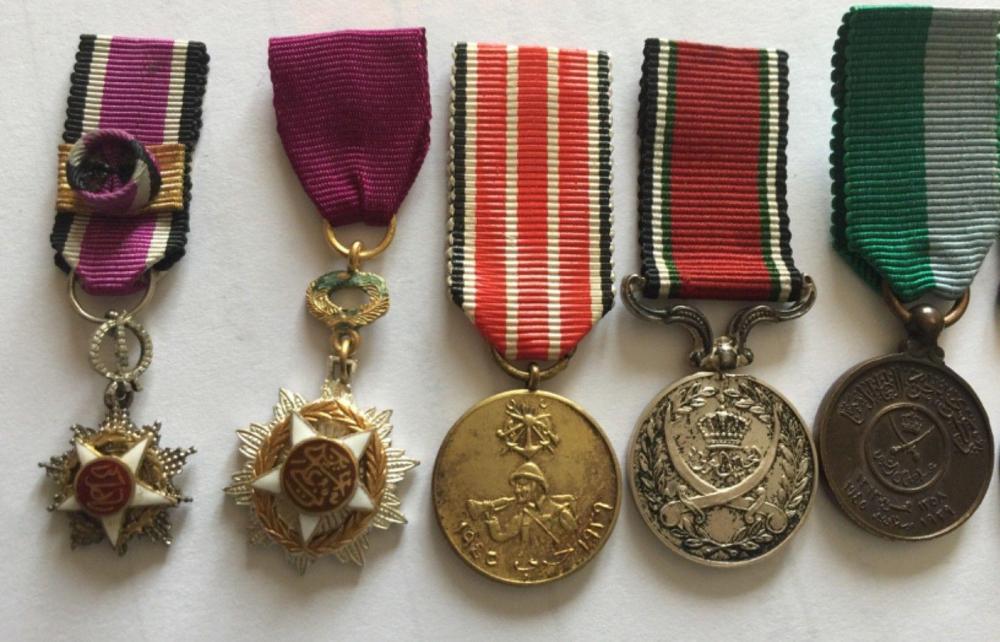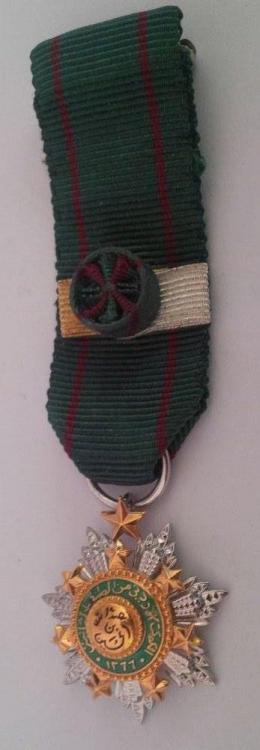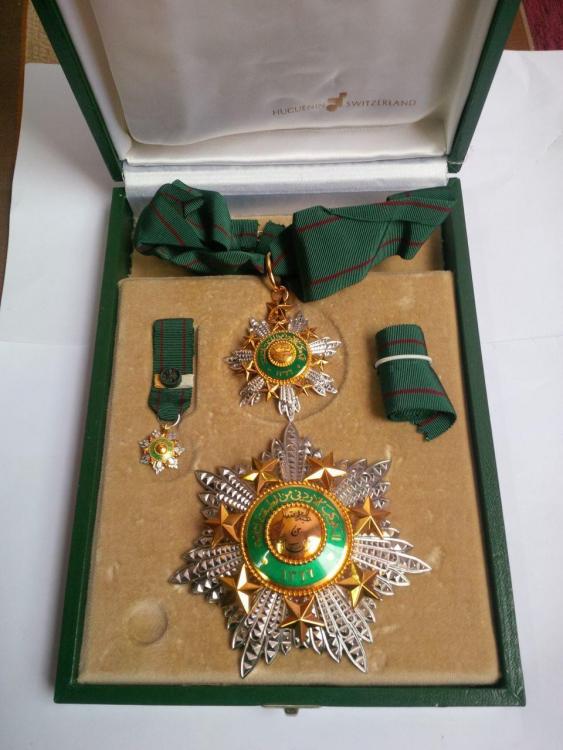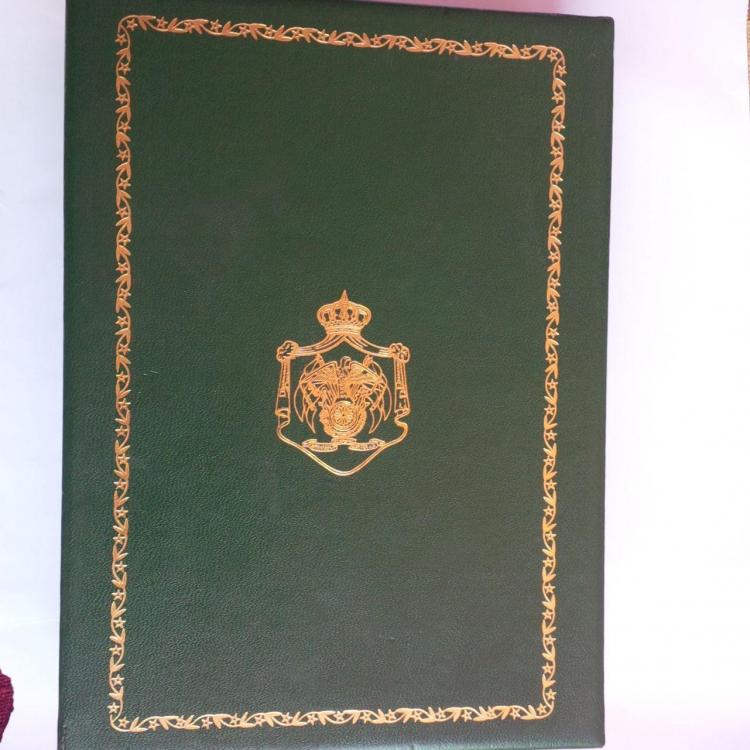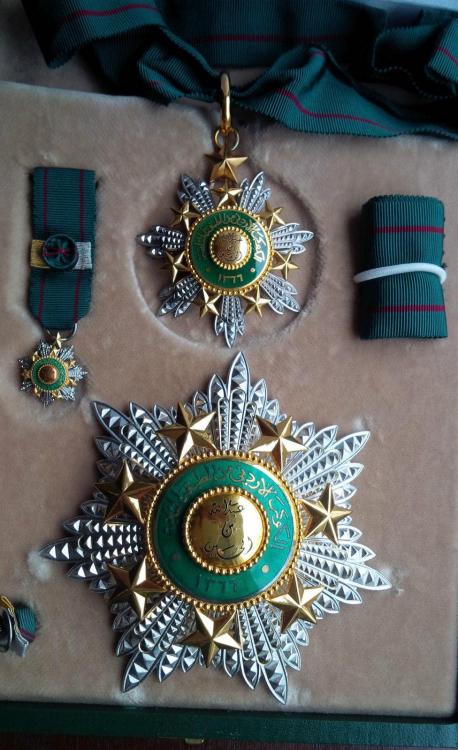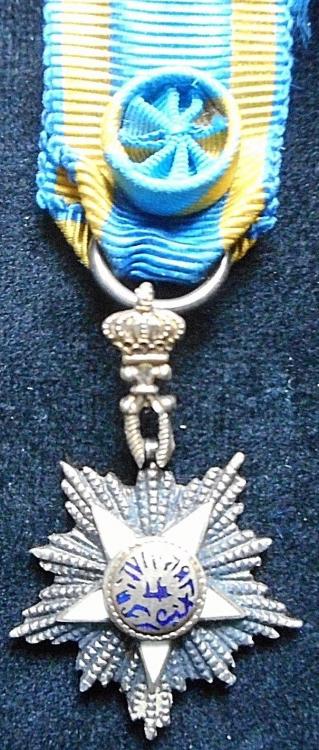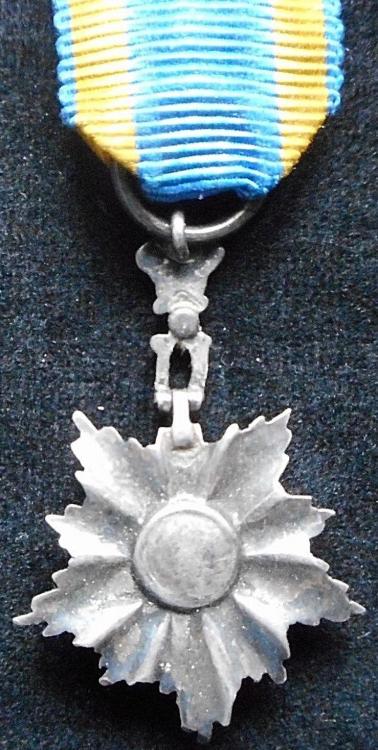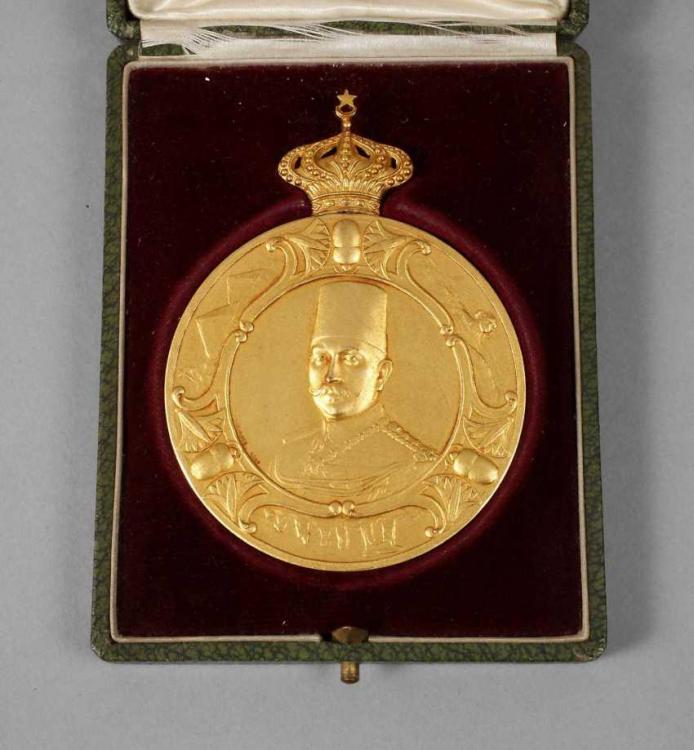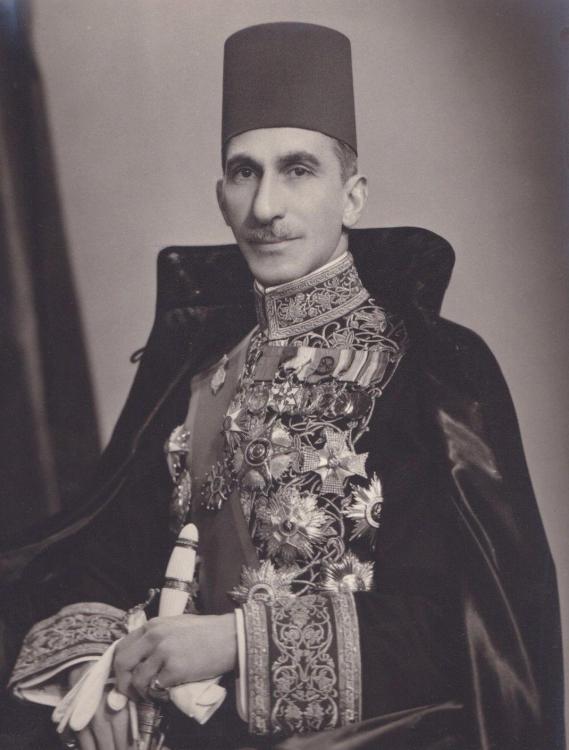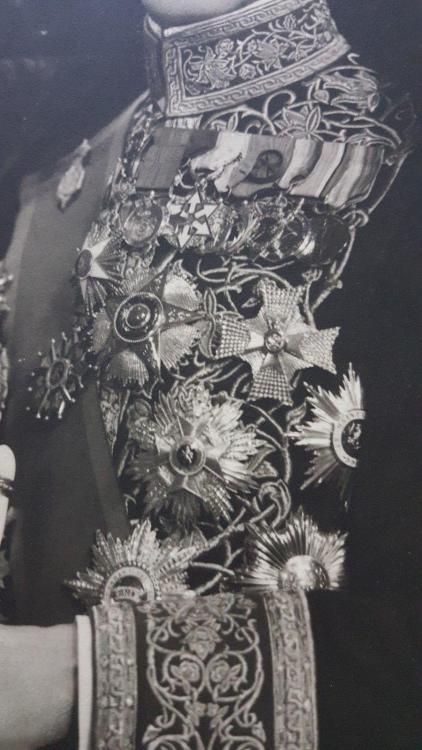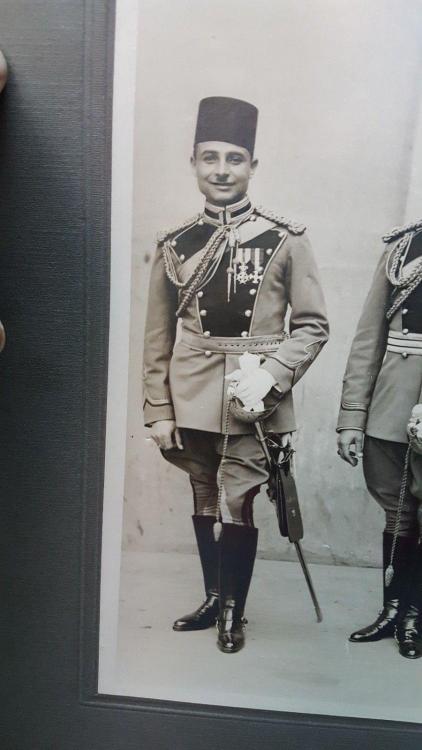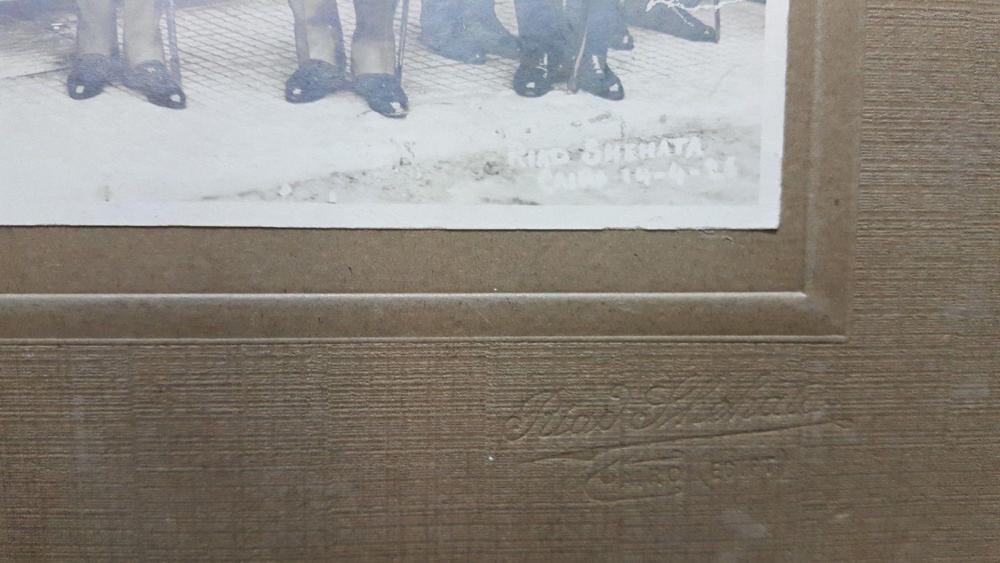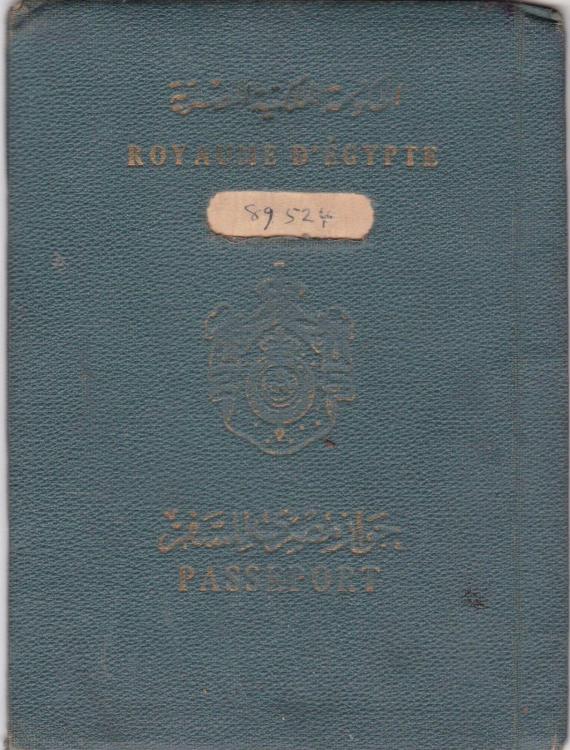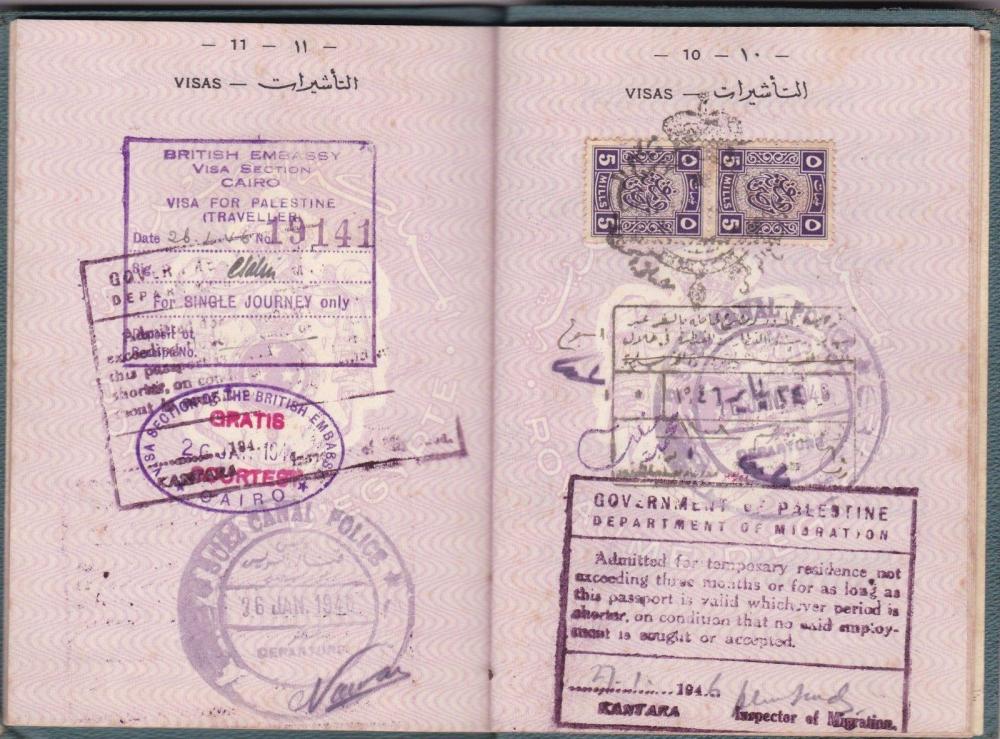-
Posts
2,429 -
Joined
-
Last visited
-
Days Won
5
Content Type
Profiles
Forums
Blogs
Gallery
Events
Store
Everything posted by Rusty Greaves
-

Miniatures of the Middle East & Arab World
Rusty Greaves replied to oamotme's topic in Middle East & Arab States
The first photo below is of another miniature of a Republic of Egypt Order of Independence (Nisah al-Istiklal) from a 2014 auction by H. D. Rauch (lot 4682), archived on the acsearch.info website (https://www.acsearch.info/search.html?term=Egypt&category=4&en=1&de=1&fr=1&it=1&es=1&ot=1&images=1&thesaurus=1&order=0&currency=usd&company=). No dimensions or manufacturer is specified for this Republic of Egypt Order of Independence miniature. This example (above) shows some differences from other miniatures of this medal I Illustrated on this thread in the 1st photo on 25 April, 2018 and in the 1st photo on 30 July, 2018. The example above notably lacks the dots present in the outer white and blue margins of the central medallion of both of the previously illustrated examples. The image above shows a group of 6 miniatures from a 2014 auction by H. D. Rauch (lot 4682), also archived on the acsearch.info website (https://www.acsearch.info/search.html?term=Egypt&category=4&en=1&de=1&fr=1&it=1&es=1&ot=1&images=1&thesaurus=1&order=0&currency=usd&company=). This group includes, from L to R, Tunisia: Order of the Republic; Egypt; Order the Republic, Syria; Order of Civil Merit; a second example of the Egyptian Order of the Republic; Lebanon: National Order of the Cedar; and Morocco: Order of the Throne. Above are 2 examples of miniatures of the Egyptian Order of Ismail from a recent 2018 auction of La Galleria Numismatique, featured on the Sixdbid.com website. On the L is a 3rd Class Commander grade of this mini, indicted by the rosette and silver galon (https://www.sixbid.com/browse.html?auction=5367&category=168960&lot=4479891). It is identified as 30 mm tall by 20 mm wide and made of silver. On the L is a 4th Class Officer mini, indicated by the rosette and lack of a galon (https://www.sixbid.com/browse.html?auction=5367&category=168960&lot=4479892). This Officer Class mini also is identified as silver and measuring 30 mm tall and 20 mm wide. Both of these appear to be older miniatures, comparable to the examples I illustrated on this thread in the 1st photo on 6 December 2017, my post of 11 Decemebr 2017, and that Owain shows in his (upper row 2nd from R) on his post here of 11 December, 2017 (and the reverse of that mini in his 1st photo on the post of 12 December 2017, also upper row 2nd from R). The two minis above and the ones I listed as comparable are different from what appears to be a more recently manufactured version I illustrated in the 2nd photo on 6 December, 2017 (on the R) that lacks the Khedival crown as part of the suspension device and is associated with the somewhat unusual mini in the L of that photo with very abbreviated design based on the sash badge (1st Class, Grand Cordon) and neck badge (2nd Class, Grand Officer along with a chest star; and 3rd Class Commander that has a neck badge only as the full-sized regalia). The configuration of the 3rd Class mini above contrasts with the example I illustrated here on 16 October, 2018 that has a rosette and silver galon, that made me wonder whether the 3rd Class mini might more appropriately be the neck badge form. Rather than representing different medal forms for different classes, these appear to show that older miniatures of the Order of Ismail (likely from before it was discontinued in 1952) are distinctly different from those that probably date even much more recently than the 1952 termination of this award (except as "royal exile" awards as discussed by 922F on 5 December 2017 in the thread I started: "Question about the Order of Ismail/Nishan al-Ismail" on 7 November, 2017 here in the Middle East & Arab States section). It appears all of the clearly older forms of the mini employ the design of the chest star for this order, and several more recent miniatures Order of Ismail medals use the sash badge/neck star design (shown in this thread on the 2nd photo of 6 December, 2017; the oddly configured modern piece in the 4th photo on 6 December, 2017 from falera-et-orbis.com inventory of "in-stock" minis; and the inexpensive eBay example manufactured in 2015 in the 5th photo from my 6 December, 2017 post, as well as that shown on 16 October, 2018). -

Neck Ribbon for Iraq Two Rivers Order
Rusty Greaves replied to Markus's topic in Middle East & Arab States
A current eMedals auction is offering a Republic era example of the 1st Class Grand Cross version of this award from ~1975. Given the interest in the beauty of this award, I hope folks enjoy the photos from their auction site of the Iraq Republic form of this. I'm also copying their description of this set and the historical information (https://www.emedals.com/iraq-republic-an-order-of-the-two-rivers-i-class-grand-cross-civil-division-c-1975): Iraq, Republic. An Order of the Two Rivers, I Class Grand Cross, Civil Division, c.1975 Wisam Al Rafidain. Instituted in 1959 and based on the Kingdom's Order of the Two Rivers. Badge: in gilt metal with red, white, blue and green enamels, measuring 62.5 mm (w) x 95.7 mm (h) inclusive of its ball and integral ring suspension, missing its ball finial at the 9 o'clockposition, on its original full-length sash; and Breast Star: insignia in gilt metal with red, white, blue and green enamels, mounted to an eight-pointed gilt metal star base, measuring 84 mm (w) x 84 mm (h), vertical pinback flanked by dual stays, scattered gilt wear on the base. Near extremely fine. In its hardshelled case of issue, award insignia and classification marked on the lid, exterior of the lid and base each trimmed in two strands of silvered beaded threading on three sides, raised platform with recessed metal beds for both awards, slight separation evident in the exterior fabric where the rear panel meets the base, case also near extremely fine. Footnote: The Order of the Two Rivers (Wisam Al Rafidain) was an order awarded by the Kings of Iraq and then the Presidents of Iraq. It was established in 1922 by King Faisal I "For Merit" and named after the two rivers, the Euphrates and the Tigris, that flow through the middle of the country. The Order was initially awarded by the Kings of Iraq between 1922, when the monarchy was established, and 1958 when the monarchy ended. It was continued by the Presidents of Iraq through the 1960s, 1970s and 1980s. It was awarded in two divisions, Military and Civil, initially issued in four classes: 1st, 2nd, 3rd and 4th, along with a medal. On May 24, 1959, the Order (now known as Wisam Al Rafidain) was awarded " For exceptional service to Iraq", now issued in five classes: 1st, 2nd, 3rd, 4th and 5th. Sash badge and chest star Sash badge Sash badge, detail of obverse Sash badge, oblique detail of obverse sash badge, detail of reverse Sash badge, oblique detail of reverse Chest star chest star, oblique view Chest star reverse Chest star reverse, oblique view Chest star, detail of pin catch on reverse Chest star, detail of pin attachment Set in case -

US Dept of State Special Agent's Badge 1917
Rusty Greaves replied to Rusty Greaves's topic in United States of America
Ulsterman, thanks for your continued visitation of this thread. Several folks on Pinterest with interest in law-enforcement badges borrow images of the first US Dept. of State badge, but they inevitably all choose the ~1989 restrike image with the enamel and less well-exectued engraving rather than the photo of the actual rare original 1917 badge. GMIC is a much more satisfying forum dedicated to accurate information, background data, and not just "pretty" pictures. The Dept. of State Special Agents originated in the early WWI period with government concerns about abuse of the US neutrality by visiting diplomats, especially Germans. The war created significant new security problems not experienced by the US Government previously, and these became even more complex in the aftermath of WWI as the US emerged from a relatively isolated nation to a world power. In the early phase of WWI, the US was subjected to an array of espionage events that violated the tenants of diplomatic immunity and placed US neutrality in danger. These included abuses on US soil as well as the treatment of US (and other countries') diplomats oversees. Violence against the British embassy in Berlin, attacks on trains carrying diplomats, and rampant interception of diplomatic communications often confused Americans with the British, although the German government tried to get the populace to distinguish neutral Americans from the British who were at war with Germany. Interestingly, this may be where the wearing of US flags on diplomats lapels originated, as Americans tried to distinguish themselves from the British. The security of diplomatic pouches was a critical issue, and the US Postal service implemented a number of security measures that made them leaders in counter-espionage as it was experienced in relation to communications. This is one of the reasons that the first US Dept. of State Special Agent, Joseph "Bill" Nye selected postal inspectors as his initial Special Agents for the Washington and New York offices. The German Embassy in Washington ran a number of espionage, propaganda, and sabotage efforts (i.e., the realized plot that resulted in a 1915 attack on 10 US factories that produced munitions for Allied countries), in defiance of US neutrality. Passport fraud also was a major problem. Prior to 1914, passports were not required for travel in most parts of Europe, however this changed and new restrictions were implemented for the issuance of US passports. Despite these efforts, abuse of the passport system was rife. The German espionage & sabotage efforts were overwhelming challenges to the US government that lacked effective experience for these challenges. Robert Lansing, the US Secretary of State, was responsible for realizing and acting to try and combat these threats to US neutrality and sovereignty. He instituted a strict pass system and escort protocol for foreigners and US citizens (including Congressmen and reporters) visiting the Dept. of State. He created a "secret service" to meet these challenges, and moved to coordinate the various agencies trying to implement better security against concerted espionage. President Wilson was reluctant to authorize Lansing's proposed overseeing agency, and he created the "Secret Intelligence Bureau" in April 1916, under the direction of Leland Harrison from the Latin American Division. Harrison coordinated collection of intelligence form various US govt and military agencies (although it was recognized this work was "extra-legal"), and had regular contact with comparable British agencies. Surveillance of the German Embassy in Washington and the German Consulate in NewYork uncovered a number of German plots. Joseph M. Nye, a Secret Service squad leader, was one of the investigators who provided significant wire-tap information from the German Embassy, specifically in relation to the German intentions to continue unrestricted submarine warfare, one of the actions that led to US involvement in WWI. Nye was assigned as the Special Assistant to the Secretary in 1917, and subsequently Lansing made him the Dept. of State's first Special Agent. Most of the first year of Nye's work was escorting foreign dignitaries, protecting them, and making all travel arrangements for them during their visits to the US. The first 3 new Special Agents he recruited were froth Postal Office Inspectors; James O'Connell, Robert S. Sharp, and Robert C. Bannerman. Postal Inspectors were widely trained in detecting fraud, theft, transportation of weapons, firearms, and other banned materials, identifying crimes affecting postal officials, and determining whether such activity was external or internal to the Postal Service. They had an array of investigative experiences and skills critical to this new of the Dept. of State Special Agents Division. As I've noted elsewhere, they opened offices in Washington and New York, with Sharp overseeing the New York office. The Special Agents Division was created just as President Wilson was preparing to declare war on Germany & Austria-Hungary. Lansing and his agency focused on diplomatic security particularly in communications as their principal WWI security effort. They also provided security for US diplomats and foreign dignitaries. They surveilled various organizations whose wartime activities were considered "disloyal", and because of the perceived threat to Great Britain by groups being funded by the Germans to overthrow British colonial rule, they targeted Irish revolutionaries and Hindu nationalists. Nye was involved in the case agains the Hindu nationalists. The Hindu group was only trying to incite rebellion against British rule (in other areas of Asia and in Africa as well), but the Irish group was being funded through German agents in Mexico that also plotted sabotage attacks in the US. The post-WWI period resulted in even greater security and intelligence challenges as the US became an emergent world power, and target for more concerted espionage. The increase in the US diplomatic presence abroad resulted in even greater needs to maintain communications security, develop secure courier services, and counter-intelligence than during the war. Nye also continued the critical role of protecting foreign diplomats visiting the US. Special challenges included escorting Japanese royalty safely despite significant security threats, and, more delicately protecting diplomats from Liberia and other African countries while accommodating Jim Crow laws and explaining other racist conventions those diplomats were expected to practice with white officials and businessmen. After WWI, security responsibilities increase, but budgetary and personnel cuts were implemented. Joseph "Bill" Nye resigned in 1920, going to work for Guaranty Trust Company to improve detection of fraud. Nye was replaced by Robert C. Bannerman. Robert Sharp lost his commission as head of the New York office in 1920 following personnel cuts reducing the Special Agents Division from 10 to 2 Agents. However, the increased responsibilities of the Special Agents Division resulted in re-hiring several of those individuals in 1921 including Sharp, again overseeing the New York Office now with a staff of 25 people. The renewed duties included internal investigations of leaks of sensitive information, theft, background investigations of potential Dept of State employees, illicit importation of liquor by the British Embassy, and passport & visa fraud that became an important tool in deporting foreign agents involved in espionage during the 1920s and 30s. 1916- Robert Lansing, 42nd US Secretary of State (1915-1920) under President Woodrow Wilson (US Library of Congress Prints and Photographs Division; Harris & Ewing Collection; File: Robert Lansing; digital ID: cph.3b47713.jpg; Created: 31 December 1918) 1917-Joseph “Bill” Nye, The Department of State’s first chief special agent, served from 1917 to 1920. Library of Congress. "1917: The first Chief Special Agent of the U.S. Department of State, Joseph M. Nye, was appointed by U.S. Secretary of State Robert Lansing in 1917 and served until 1920. His principal duty initially was to monitor enemy diplomatic activities in Washington and to protect foreign dignitaries visiting the United States, during the period of the First World War." (Source: Library of Congress; direct quote from: https://www.state.gov/m/ds/rls/c31108.htm) http://www.afsa.org/ds-100-tradition-vigilance Joseph Nye's US Dept, of State Special Agents Division credentials, cancelled in 1920 when he left the Dept. of State. https://www.flickr.com/photos/usdiplomacycenter/25569676257/in/photostream/ https://diplomacy.state.gov/archives/438#gallery[photonic-flickr-set-1]/25569676257/ Cover of Joseph Nye's US Dept, of State Special Agents Division credentials https://www.flickr.com/photos/usdiplomacycenter/38630527820/in/photostream/ https://diplomacy.state.gov/archives/438#gallery[photonic-flickr-set-1]/38630527820/ "1920: Robert C. Bannerman replaced Joseph M. Nye as Chief Special Agent in 1920 and served in that position until his death in 1940. He expanded the tasks of the office to include personnel background investigations, passport fraud, courier oversight, and internal investigations. His son Robert L. Bannerman was appointed head of the Department's Security Office in 1945." (Source: DS Records /1920) https://www.state.gov/documents/organization/176705.pdf -
Welcome Lmaas1 and thanks for posting more images of bows & arrows! Sorry for my delay in collecting my thoughts about your arrows-but I'll let fly with my ignorance and conjecture... I agree with Peter the the bow is certainly unassociated with the arrows, and for the same reasons. The laminate construction and grip's configuration marks it as a "recent" European bow. The arrows you illustrate would have been associated with a traditional "self" bow, as Peter notes the stave would have made from a single piece of wood lacking the laminate construction. Some older European-style bows were tillered to have the form of the grip in the image, but again carved from a single piece of wood. The well-known Sudbury bow from 1660 (in the Peabody Museum of Archaeology and Ethnology at Harvard) is the earliest example of a North American Native American self bow (possibly Wampanoag) and does show a thicker grip region, but not comparable to the modern bow in your photos. The arrows you illustrate would have been used with a very different form of bow, depending where they actually do come from, and that is not clear to me. If they are from South America, they would have been used with a palmwood bow similar to that shown in Stuka f's photos and those I illustrated in the thread that you found in his section. The arrows are certainly ethnographic, but the region they come from is a bit problematic. 40 inches is quite short for most South American arrows (most are at least twice this length up to ~2 m long), although boy's arrows will be smaller than those used by adult men. Some groups did make arrows that were sold to outsiders, often they were shortened because of the demand for arrows that were easier to transport back to he visitors' homes (having returned hundreds of South American Native arrows back to the US, it is a complex task to bring long arrows any great distance). The length is also too long for most North American arrows. The point forms of the lanceolate steel-tipped arrows with central mid ribs is very uncommon among South American (even more so for North American) arrows, normally S. American lanceolate points are flat because they were made from scrap pieces of worn out machetes or knives, often retaining the casting elements of those blades. The mid-ribbed lanceolate points suggests manufacture on an a grooved anvil, or casting, practices more common in east Africa where dedicated village metallurgy served a variety of local technological needs. In most other parts of the world, steel has been obtained principally through recycling of worn-out tools, trade in raw materials (usually already manufactured steel points or worn-out tools), or from scavenging scrap from household dumps of the wealthy (often foreigners or non-indigenous local residents). Such blades with mid-ribs are best known for hand-held spears from Africa (fewer arrowhead forms have a mid-rib), that would have wooden hafts and no fletching (feathers at the proximal end to stabilize flight). If these are New World arrows, they would likely be from an area where sufficient trade between outsiders & Native folks occurred that the European-descendant folks would have manufactured such mid-ribbed points, specifically for trade with indigenous peoples (some parts of Brazil?). The elaborate, multi-barbed points appear to be made by heating and cutting the barbs (using an axehead, machete, or other hard steel implement) and are quite time-consuming to manufacture. Interestingly, the 4 non-lanceolate arrow forms are all principally fishing arrows. In the third photo showing the point forms, the arrow on the left has the multi-pronged fishing head similar to a hand-held leister, and often these arrow forms are thrust into water in a manner similar to spears to catch fish (as you note it is fishing arrow). I cannot tell if this example has barbs, but such points are effective either unbarbed or with some barbs. Interestingly, this is the longest arrow in your group, and even though it is fletched, a hand-held use, in addition to occasionally being shot from a bow, is quite likely. The short barbs on the other 3 non-lanceolate arrows also indicates design for fishing. The arrow second from the left has a large distal barb and the shorter barbs on the proximal portion of the squared x-section of the steel point. Both of these elements are critical in holding a fish on the arrow until it can be retrieved. The other 2 arrows to the right of this one that appear square in x-section with small, cut barbs that keep fish from slipping off the arrow point. Interestingly, none of these arrows show a long foreshaft, a piece of hardwood that the point is seated into and then pushed into the mainshaft (usually with a resin or glue). The advantage of foreshafts is that the hardwood holds the point securely, even if the arrow is damaged in flight or by the animal once struck. They also often are pre-made, with a point seated in a foreshaft, for field repairs should the original distal armature of the arrow break in use. Except for the leister, all of the other arrows may have very short foreshafts, it is quite uncommon to seat a point directly into the lighter weight arrow mainshaftt because the shock will damage the distal mainshaft. Most South American arrows have long and quite visible fore shafts of dark red or brown hardwoods. This also is true for most Asian arrows where we have good descriptive e & illustrative literature (especially Papua New Guinea and the Philippines). The mainshaft of the arrows (the long tan portion that looks like bamboo) is probably a cultivated arrowcane. Different species are used in different parts of the world. So until the probable location of origin for these points can be determined, it isn't possible to say from photos which it is, nor are photographs particularly useful in narrowing down the plant to help identify where they were made. South American arrows all use mainshafts, as do those made in other parts of the world. Some African hunter-gatherer groups (such as the pejoratively-termed "Bushmen" of Botswana, Namibia, & adjacent areas of southern Africa or Congo Basin "Pygmies") have common arrow forms that lack separate mainshafts & foreshafts, but principally on their small poisoned arrows. All of your arrows are fletched, although the feathers are missing from 2 of them. Fishing arrows often are used unfletched, the shooting distance is much shorter than for terrestrial game. Sometimes the mainshafts retain fletching because all elements of arrows are repaired and re-used, and often different points are put into arrows that formerly held a different style of point. The fletching is tangential, where whole segments of feathers are laid along the length of the mainshaft (modern target arrows use radial fletching, where the feather is split through the vein and each half of the feather is attached to form a raised "fin", modern competition arrows use radial fletching and now employ very low profile fletching [micro-fletching] that stabilizes the arrow better than larger amounts of fletching that just create additional drag). This is the simplest and fastest manufacturing method of attaching feathers. Your arrows' fletching feathers are bound at the ends, again a less time-consuming method than other techniques that bind the feather tighter to the mainshaft. While tangential fletching does not produce the most ideal flight characteristics (as radial fletching does), most traditional arrows are not designed for long distance flight. In hunting terrestrial game, most indigenous bows & arrows (for that matter atlatls [throwing sticks & long darts used among Australian Aborigines, Eskimo people, Maya & Nahua populations in Mexico, and widespread prehistorically before the invention of the bow], blowguns, and throwing sticks) are never used for distances greater than ~30 m, and that is a wildly risky outside shot. Fishing arrows are normally used for distances no greater than ~2 m, but the skill to compensate for refraction through water is a considerable feat. The windings of the fletching appear to represent at least a couple different materials. In your 5th photo showing the proximal ends of all the arrows, the 5th from the left (a lanceolate arrow missing its fletching) looks like a form of vine. The others may be a variety of different materials (commonly plant fibers, but possibly animal sinew, if they are not South American arrows). At least the 1st, 3rd, 4th, and maybe the 6th from the left show traces of some kind of resin attached to the bindings (this can be beeswax based or made from other tree resins, all of these usually combine at least a couple varieties of other materials as well). All of the proximal ends appear to have nocks (a groove in the mainshaft to fit the bowstring on), that you note are carved in the mainshaftt. Take an additional look, if you have not already, to see if all are just in the mainshaft cane or possibly inserted hardwood plugs. The particular form of the nock (carved or just worn from use in the mainshaft versus a carved plug inserted in the proximal end of the mainshaft) can be important in helping to narrow the geographic origin of arrows. All except the 5th arrow have windings at this proximal end that is designed as a reinforcement to prevent the mainshaft from splitting (the 5th shows traces of resin from previous windings). The 6th arrow appears to have vine as the initial winding of this nock reinforcement, and it may be covered with the use of a different plant fiber, but it is hard to tell from the photo. These windings show evidence of the use of resin to help the nock windings adhere, and possible to completely cover them with resin as well. The fletching is usually the portion of the arrow that suffers most from transportation, drying out in less-humid climates, and the depredations of insects, so it is common that the fletching is not in pristine condition. The feathers used in the fletching are not necessarily diagnostic elements. Large feathers are common on South American arrows, but not necessarily useful as defining origin there. Several in your group look like members of the hawk family, and those are used in many parts on the Americas, similar-looking feathers are employed in other parts of the world as well. The black fletching on the one lanceolate arrow is consistent with some feathers used in South America. Many Asian groups do not use any fletching (especially some New Guinea groups). The decorative carving on the proximal end of the mainshaft, distal to the point and the aluminum sleeve (likely an add-on, possibly by a past owner as heavy lanceolate points can become loose if the the windings dry out, become damaged, or if there is damage to that part of the mainshaft), is not distinctive enough to unambiguously identify the origin of these arrows. There is a possibility that these arrows are not all from the same group of people. I am very confident these are not North American arrows. They do not strike me as obviously identifiable with a particular South American region or group of people, although there may be areas with the lanceolate points that exhibit mid-ribs that I am not able to research here in my study. The shortness of the foreshafts (or possible lack of any on some arrows?) and the overall shortness of the mainshafts is anomalous among most South American arrows, again unless these were intended for trade with tourists. The point forms lack some of the complex styles ("exuberant" is the term used by one researcher working with Agta foragers of the Philippines) used in Asia and New Guinea. South America is still a likely source for these arrows, but the oddities suggest a population in fairly consistent contact with outsiders. The short length is not uncommon among groups who trade forms of their arrows to outsiders. Additionally, giving up large pieces of steel is not usually seen among populations with restricted access to metal, but might be more common if people were living in proximity to outside sources of metal (or pre-made points made specifically for trade with indigenous groups). The lack of any wooden arrows in this group also suggests a source among Natives living in proximity to sources of metal. The arrows in Stuka f's illustration are all wooden-pointed forms, and are likely no older (and possibly more recent) than yours, simply indicating they probably came from a more remote community. The dominance of fishing arrows does argue in favor of a South American origin. Most Indigenous folks are more willing to exchange these forms of arrows than the lanceolate types that have the more valuable large pieces of steel. It appears the lanceolate points in your collection may not be of the largest dimensions seen in South American (or other regions') arrows. These arrows are not old. The lack of any wooden points at all in your assemblage suggest more recent origin. They most likely date to the early mid-20th century when significantly more travel occurred into indigenous areas, and this is true in many parts of South America where a range of individuals involved in oil exploration, exploitation of other forest products, assistance with development projects, or travel for fun were interested in obtaining Native crafts. Arrows are one of the most common items that visitors purchased or traded for, and South American Natives are much more willing to exchange arrows than almost any other technology (they are used in many groups quite commonly as a "currency" in trade relationships with other indigenous folks). Your source could very likely have been given these by another traveler without having gone to the location they are from, again as arrows are not that hard to obtain and someone returning would probably have more arrows than other kids of indigenous artifacts they got during their travels to give as gifts to family or friends. They also are not valuable, first because there is no clear provenience for them, and second arrows were such a common item to obtain in travel. I would urge you to be cautious in "refurbishing" your arrows. Inexpert "repairs" detract from the authenticity & any potential value of these items. I would suggest using small amounts of beeswax to stabilize some of the loose windings or re-attach the fletching. Beeswax is completely reversible and does not stain most plant materials. It is easy to work with if you pinch off small amounts and make it pliable from the heat in you fingers, pressing it onto the pieces you wish to hold down. Craft stores or fabric stores with diverse sewing materials will usually have small blocks of 100% beeswax. You may not want to completely stabilize all of the windings, you do want to be able to observe what the raw materials are for continued attempts at better identifying their provenience. The best way to display (or store) arrows is to support them in two places (one hook near the distal end to support the weight of the metal points) and hang them on the wall. This prevents additional warping, keeps them away from insects on the floor, allows you to monitor their condition, and the visual display on a wall grabs peoples attention much more than a group of arrows leaning against a wall in a corner. They don't have to be completely level to help prevent warping, a slight angle gives the illusion of flight and yet keeps them from becoming more damaged. Sorry for such a long-winded diatribe without giving you what you really wanted to know. I'll continue to think about these arrows for a while and see if I can add any information useful to you. Welcome to GMIC & have fun with your arrows!
-

Egypt Khedivate Judge's Badge question
Rusty Greaves replied to Rusty Greaves's topic in Middle East & Arab States
To follow up on a couple additional aspects of judges' costume, I want to illustrate a few images of post-termination of the Mixed Courts and pre-Republic period when all judicial duties were given to new National Courts that assumed the jurisdiction over cases involving foreigners as well as Egyptian citizens. These first photos show the use of non-official dress (perhaps only outside of he courtroom?) related the Egyptian judge I illustrated in the final photograph (6th image) on my post of 12, September 2018. I mentioned in that post that there were 2 additional eBay photos of this judge in traditional dress without his judge's sash and the crescent & stars emblems he wears in that image (included below for comparison). I am including the those photos I referenced here, below the one of the judge wearing his sash with crescent and star emblems. In both portraits, he wears a light-colored gallebaya without his judge's sash and emblems. I have no information about what court this judge may have served, and do not know if the use of traditional clothing suggests it is part of one of the Muslim or another division of National Courts that replaced the Mixed Court system. Above is the Egyptian judge wearing a tri-colored sash (probably similar in color to that illustrated on 27 April, 2018 on this thread) with the crescent and multiple star emblems, previously posted here on 12 September, 2018, from a current eBay auction of an original 14 x 9 cm black & white print (https://www.ebay.com/itm/EGYPT-OLD-VINTAGE-PHOTOGRAPH-Judge-with-the-scarf/273147885787?hash=item3f98e1f8db:g:5lkAAOSw13ZayXDv:rk:33:pf:0). Unlike the other post-1949 judges I have found photos of, this individual wears more traditional Egyptian costume with the judicial regalia (sash with crescent & stars). Unlike all other photos I have seen, he wears a turban rather than a fez, along with a dark traditional tunic (gallebaya) that is unlike the coat of the Mixed Court era (see the 2 illustrations of the same Egyptian judge in Appeals Court regalia posted on this thread on 27 October, 2017) or the western-style jackets more common among the 1949-1953 as shown in several posts here on this thread (see 3rd photo on the post of 27 April 2018; the 4th &5th images posted on 12 September, 2018; and the 3rd & 4th photos posted on 31 October, 2018). The same judge, identified as working in his office, wearing a turban, gallebaya, but no official judicial regalia. From a current eBay auction of an original 14 x 9 cm print (https://www.ebay.com/itm/EGYPT-OLD-VINTAGE-PHOTOGRAPH-Judge-in-his-office/273147887546?hash=item3f98e1ffba:g:k~oAAOSwlJlayXGK:rk:30:pf:0). The same judge outdoors in turban, gallebaya, and without judicial regalia. From a current eBay auction of an original 14 x 9 cm photographic print (https://www.ebay.com/itm/EGYPT-OLD-VINTAGE-PHOTOGRAPH-Judge-standing-on-the-bridge/312105737674?hash=item48aaf39dca:g:OPsAAOSwH1VayXIX:rk:31:pf:0). As a correction, the second photo I posted on 27 April, 2018 that was identified on the eBay site and an Egyptian Judge, appears to be wearing regalia that suggests the Egyptian or Libyan Parliament (I have included it below as well). He is not wearing judicial regalia. The man in the 27 April image is wearing a watered silk sash (with a darker border) with the crescent with 3 stars closely spaced within the arms of the crescent that is part of the sash emblem for members of the Egyptian Upper House of Parliament, and a lapel pin with 8 major rays. The Libyan regalia is similar in design to the of the Egyptian Upper House of Parliament, as noted by Owain on 18 May, 2016 on the thread "Libya - unknown order and medal" started by James Hoards on 15 May, 2016 here in the Middle East & Arab States section: The visible lapel badge on my 27 April posting (and below) has 8 major rays, in contrast with the 6 rays of the Egyptian Upper House of Parliament badge (see eMedals image below). Additionally, the watered silk sash has a darker border that I have not seen for the Egyptian parliamentary sash. That photo is identified as coming from Egypt, although no studio is specified. Does anyone know if there were other variants of this regalia for Egyptian officials? Photo I posted on 27 April of an alleged Egyptian judge, whose regalia may indicate he is a member of the Egyptian Parliament (or Libyan?). I am correcting my past illustration of this individual as a post-1949 pre 1953 judge because of the bordered sash, configuration of the crescent and 3 stars, and the lapel badge. This 14 x 9 cm original print is from a past eBay auction with the identification: "Egypt old vintage photo of judge with scarf". https://www.ebay.com/itm/EGYPT-OLD-VINTAGE-PHOTOGRAPH-Judge-with-the-scarf-/273105393192?nordt=true&orig_cvip=true&rt=nc&_trksid=p2047675.m43663.l44720 An identified Egyptian sash with crescent & star insignia, the sash badge, neck badge, and lapel badge for a member of the Egyptian Upper House of Parliament is shown below from an eMedals past auction listing https://www.emedals.com/africa/egypt/an-egyptian-upper-house-of-parliamentary-set-w1572). This shows that the neck and lapel badges have a configuration of 6 major rays in contrast with the 8-rayed lapel badge visible in the other images here. The sash of green watered silk also lacks the darker border shown in the image above and the the two photos Below is a better photo of an individual wearing the same regalia seen in the 27 April, 2018 image I am correcting as not representing a judge, but the photo below shows all of the regalia that is partly covered in that 27 April image. This is from a current eBay auction (https://www.ebay.com/itm/Armenian-photographer-in-Egypt-member-of-the-Egyptian-Upper-House-of-Parliament/273500928337). The seller initially identified this man as an Egyptian judge, but I am currently unsure whether this represents a member of the Egyptian Upper House of Parliament or possibly a man wearing that for Libya, given the differences between the sash border and number of rays on the lapel badge compared with the eMedals example shown above. Both portraits (below and on 27 April) show an 8-rayed lapel badge. The sash badge attached to the decorative knot shown in the eMedals image above and the photograph below are 8-rayed . The photo below is identified as from Egypt, taken by an Armenian studio, K. Papazian in Cairo, and is an 18 x 13 cm original print. Below is another individual in a photo from a current eBay auction (https://www.ebay.com/itm/EGYPT-OLD-VINTAGE-PHOTOGRAPH-Judge-With-a-medal-and-scarf/273500915471) identified as an Egyptian judge, but wearing regalia that suggests either an Egyptian or Libyan member of Parliament. What is visible of his sash shows a lighter border than that of the individual above or the man I initially illustrated on 27 April (but it is very difficult to determine color or hue in black & white photos). The sash does have the same crescent & 3-star emblem of Parliamentary regalia. The lapel pin shows 8 major rays. Unlike the individual above, this man wears a turban and gallibaya. This 22 x 15 cm original print is said to be from Egypt, but no studio is identified. -

Egypt Khedivate Judge's Badge question
Rusty Greaves replied to Rusty Greaves's topic in Middle East & Arab States
Below is an unusual image of another post-1949 & pre-revolution individual identified as a a judge. The hand-tinted, matted original studio print (23 x 18cm) has a bicolored sash (lighter colored stripe [green?] worn uppermost) with the crescent and 1 star in the superior position. What seems unusual to me is that this man is wearing a white uniform (rather than the more common western-style suit at this time period) and is identified as a police officer (at the same times his judicial appointment?). The eBay listing identifies the name Ali Arafa, of Port Said, but I do not know if this is the subject's name or the studio name. I am including close-ups of the inscriptions on each of the lower corners. (https://www.ebay.com/itm/EGYPT-VINTAGE-PHOTOGRAPH-POLICE-OFFICER-Judge-HAND-COLOR-ALI-ARAFA-PORT-SAID-/273502359767?_trksid=p2385738.m4383.l4275.c10) inscription on the lower R of the above photo. inscription on the lower L of the above photo. -
922F, again I am most indebted for your knowledge of these medals that helps me to better understand the materials I have been researching about the Order of Ismail, and the many other paths that that takes me. I can't thank you enough for your help in augmenting what I have been looking into so that I can appreciate a deeper amount of contextual information beyond simply identifying the Order of Ismail that my wife's great grandfather was awarded. I found a few very high-resolution images of an Order of Ismail chest star from a 2017 auction by Bukowskis to add to this thread (https://www.bukowskis.com/en/lots/906508-the-order-of-ismail-nischan-al-ismail-22k-gold-and-silver-lattes-in-kairo-1928-1929-weight-ca-81-g#). This medal is identified as weighing ~81 g, and has a diameter of ~7 cm, although the auction site does not identify the class of this star, the 70 mm diameter indicates it is the 2nd Class Grand Officer version of this award (the Grand Cordon chest star is 81 mm in diameter). This example was made by Lattes of Cairo. Here is a high resolution close-up photo of the central medallion enameled "Ismail" inscription from the same Bukowskis 2017 auction (https://www.bukowskis.com/en/lots/906508-the-order-of-ismail-nischan-al-ismail-22k-gold-and-silver-lattes-in-kairo-1928-1929-weight-ca-81-g#) And below is a nice lateral view of the chest star, again from the same example on the Bukowskis 2017 auction (https://www.bukowskis.com/en/lots/906508-the-order-of-ismail-nischan-al-ismail-22k-gold-and-silver-lattes-in-kairo-1928-1929-weight-ca-81-g#)
-

Miniatures of the Middle East & Arab World
Rusty Greaves replied to oamotme's topic in Middle East & Arab States
I was recently looking up images of the Iranian Order of Homayoun medal in relation to a photograph of an Egyptian Royal Guard wearing the Order of Ismail and other medals. 922f was kind enough to identify some of the other medals I was unfamiliar with that the Guardsman was wearing, among them the Iranian Order of Homayoun. I found a few illustrations of miniatures of the Order of Homayoun that I am including below, as well as comparative full-sized medals because these don't seem to be well-illustrated here on GMIC. 922f has illustrated a miniature of the Order of Homayoun on this thread on 10 December, 2017 in the leftmost medal on the photo in that post, the ribbon having a rosette with no salon indicating it is the 4th Class of this award. In addition to some variations noted here, his example has another unique configuration of the sun's rays on the central enameled medallion and lacks the knotted wire suspicion device, also seen below in the 4th & 5th photos of the obverse & reverse and the close up of a same miniature, in the 6th photo as well, also of a 4th Class version of the medal. Below is an image of the miniature of what is probably the 5th Class version of the Knight's Cross version of this award from a 2018 auction by NumisBids (https://www.numisbids.com/n.php?p=lot&sid=2602&lot=4266). It is described as silver & enamel, measuring 15 mm in diameter (the full-sized medal measures ~59 mm), and was made by Arthus Bertrand of Paris. Below is an illustration of the full-sized award for comparison; a 5th Class version of the Knight's Cross from a 2016 auction listing of La Galerie Numismatique from the Sixbid.com website (https://www.sixbid.com/browse.html?auction=3116&category=63942&lot=2606766). This example is identified as silver gilt with enamel, measuring 59 mm (in diameter), is hallmarked "800", and was made by Arthus Bertand, Paris. And below, is an illustration of a full sized example that is identified as either the sash badge (probably not) or a 5th Class Knights Cross (almost certainly) for the Order of Homayoun from a Goldbergs Auctioneers auction of 2018, archived on the Sixbid.com website (https://www.the-saleroom.com/en-gb/auction-catalogues/goldberg-auctioneers/catalogue-id-srgol10019/lot-353997b1-3f3d-43e7-a59b-a93d01155489). I am including this image not only for the variation in the execution of the obverse design, but also because it shows the maker's (Arthus Bertrand of Paris) hallmark on the reverse. It is identified as silver gilt with enamel, measuring 60 mm in diameter. Details of the sun's rays and the lion's tail seem to be the most apparent variations in this version compared with the La Galerie Numismatique example. The sash badge of the 1st Class Grand Cross of this order has the 4 rayed embellishment, while the breast badges for the other classes are 8-rayed, and the neck badges have 6 rays. Most of the sash badges I have seen illustrated for the Grand Cordon have the suns rays radiating 360 degrees in the enameled central medallion, as does the chest badge (which also has green enameled central rays for each of the 8 embellishment rays). All the other classes have the rays extending only in the upper right third of the medallion design. There appears to be significant variation in the design details of not only the miniatures of this award, but among examples of the full-sized awards as well. Below is a miniature of the Order of Homayoun from a past eMedals auction (https://www.emedals.com/middle-east/iran/iran-order-of-lion-and-sun-w0068). The listing calls it the Order of Lion and Sun, it is silver and enamel and measures 21mm in diameter. The rosette without galon indicates it would be the 4th Class of this award. Obviously the casting does not have the detail of other miniatures, it has much more abbreviated detailing to the enamel central medallion, and lacks the knotted wire suspension device. Obverse and reverse of this eMedals miniature of the Order of Hamayoun Detail of the casting and central medallion of this miniature Order of Hamayoun from eMedals. Below is an image of a miniature of the Order of Homayoun is illustrated below from Frontiernet.net website: (http://www.frontiernet.net/~jackiebush/pages/Rosette_Medals2.html). This example with 6 rays, a rosette, and the galon of gold and silver (in correct orientation of gold on the L and silver on R) indicates this is the 2nd Class of this award. No dimensions or other information is provided about this miniature. Below is additional example of a miniature of the 2nd Class Order of Homayoun displaying differences in the execution, from the najafcoins.com website: (http://www.najafcoins.com/Pahlavi_Ghajar_Dec.htm) & (http://www.najafcoins.com/Images/o2702). The listing identifies it as the miniature of the Grand Cross Class, although the 6-rayed configuration, rosette, galon, and the central medallion sun's rays only in the upper R third would indicate it is the 2nd Class. The listing states it is a "Special Class in gilt". It is unclear if the central medallion is enamel or painted, but the design is cast into the medallion and minimal coloration is present. Additionally, the twisted wire suspension is different from other miniatures. And for comparison, below is an illustration of the full-sized neck badge (6 rayed, and the chest badge is 8-rayed) for the 2nd Class Order of Homayoun from a past eMedals auction (https://www.emedals.com/an-iranian-order-of-homayoun-2nd-class-set). The full sized neck badge measures 77.5 mm tall by 67.5 mm wide. No manufacturer is identified for this set of neck badge and the chest star. -
922f, Many thanks for identifying the other medals I am unfamiliar with (I do know the Medal for Meritorious Action or Medal of Devotion, but am not knowledgable enough to determine they are the likely hidden culprits in this image). Is the four-rayed version of the Order of Homayoun worn on a chest ribbon likely the 5th (Knight) Class of this award? The Order of Leopold appears to have a dark ribbon (blue with the central black stripe?) with a rosette and lack the crossed swords below the crown (a wartime addition). Given the varieties of this award, would this be the Civil version Officer's Cross, or which do you think this represents? Variant forms of the Officer Class of the Order of Leopold II are shown in the following illustration here on GMIC: one by g-deploige on 15 June, 2006; oli4vercammen illustrates 2 Officer Class medals on 15 August 2006; and bilylev shows a very distinct Officer Class version he identifies as from the "time of the Congo state" (or is "Type I" a better term for the central medallion design this variant?) on 30 December, 2013, all on the "Belgian Order of Leopold II" thread started by Laurence Strong on 9 November, 2005 in the "Europe & Baltic States" section here on GMIC. That mark between the Khedive's Sudan Medal and the Order of Homayoun does not appear to be a button, given the configuration of the uniform. It may be a spot on the image rather than anything this guard is wearing (there are a couple stains on this image, one just below the Order of Homayoun). I also am interested to look up more about the Order of Leopold as a name of a Belgian judge of the Egyptian Mixed Courts (one of the subjects I'm interested in here on GMIC) is associated with one of the beautiful Judicial Badges also was a recipient of the 5th Class (Chevalier/Knight) Ordre de Leopold, and perhaps that may help me track down more information on his judicial career. In the 13 January, 2016 post I mentioned by Chris W, he states that King Victor Emmanuel III of Italy visited Egypt in 1933 before his abdication, do you know how that visit or other associations would have resulted in the distribution of the Italian Order of the Crown to several Royal Guards? As I did not find an image of the Iranian Order of Homayoun (is the term "Sun and Lion" used on auction listings an appropriate English term for this order, since the symbolism appears on many other Persian/Iranian medals?) here on a quick search of GMIC, I am illustrating a 5th Class version of the Knight's Cross from a 2016 auction listing of La Galerie Numismatique from the Sixbid.com website (https://www.sixbid.com/browse.html?auction=3116&category=63942&lot=2606766). This example is identified as silver gilt with enamel, measuring 59 mm (in diameter), is hallmarked "800", and was made by Arthus Bertand, Paris.
-

Egypt Khedivate Judge's Badge question
Rusty Greaves replied to Rusty Greaves's topic in Middle East & Arab States
Here are a couple additional images of post-1949 judges wearing the judicial sash and the crescent and star emblems that replaced the regalia of the Mixed courts that were in place from 1875 until 1949. The crescent and star probably disappeared as judicial emblems shortly after the 1953 revolution, replaced by the Eagle of Saladin, but retaining the 3 stars (usually positioned above the Eagle, but see the example of a Republic era judge I posted in the 3rd photo on 12 September 2018 in this thread with 2 stars below the crescent and 1 above). These 2 individuals below show the same orientation of the bicolored sash with the lighter color (green?) in the lower position, but note the images on this thread of other post-1949 judges (the 4th and 5th photos on 12 September) who wear the sash with the lighter strip orientated in the inferior position. The judges in the 4th & 5th photo also sport only 1 star above the crescent, and note also the post-1949 and pre Revolution Egyptian judge in the 6th photo on 12 September who wears a three stripe version of the sash that appears similar to that used for the Parquet during the period of the Mixed Courts, in addition to the multiplicity of stars adorning his sash (3 large stars below the crescent, 3 large stars above the crescent, and 3 smaller stars above the upper 3 larger stars). Both judges' sashes exhibit the elaborate fringed knot used during the period of the Mixed Court era at least for the Appeals Court judges and possibly those of the District Courts (and the Parquet?) as well. I illustrate these post-Mixed Court period photos to show some of the derivation of the judicial regalia that derives from the Mixed Courts into the post-1949 judiciary, and is later adapted to the post-Revolution period judges sash & emblems. As more of these photo exist from this period, they also demonstrate some of the variant configurations of judicial regalia that are either undocumented in easily accessible literature, or subject to some whims of the judges themselves. Post-1949 Egyptian judge wearing the sash, crescent, and 3 stars. The Fez has been retained as part of the judges regalia, but the high-collared long tunic-style jacket of the Mixed Court era has been replaced with a European style coat. From a crest eBay auction of an original 14 x 9 cm print from the Studio Vart (?): https://www.ebay.com/itm/Old-Armenian-photographer-in-Egypt-Judge-With-a-medal-and-scarf-STUDIO-VART/273500934866 A young judge in the post-1949 period, also wearing a western style jacket and leaving his fez on the table where his right hand is resting. From a recent eBay auction or an original 23 x 16 cm print froth studio Adel (?):https://www.ebay.com/itm/EGYPT-VINTAGE-PHOTOGRAPH-A-young-judge-with-scarf-studio-adel/273502381828 Close-up image of the sash and crescent with stars regalia of this same young judge shown above. https://www.ebay.com/itm/EGYPT-VINTAGE-PHOTOGRAPH-A-young-judge-with-scarf-studio-adel/273502381828 As a further interesting illustration of variation in depiction Egyptian judges at this time period (and in the spirit of the US celebration of Halloween), here is a boy dressed in a hybrid judges costume that includes the fez, a more European-style robe, and a sash with the crescent and 3 stars that is actually an abbreviated form of the French epitoge, which is the French academic and judicial scarf, derived from the medieval chaperon, and is the counterpart of the English academic regalia's hood. This is an original 14 x 9 cm print, possibly titled "The Little Judge" from the studio Photo Charles. From a current eBay auction: https://www.ebay.com/itm/EGYPT-OLD-VINTAGE-PHOTOGRAPH-CUTE-BOY-The-Little-Judge-PHOTO-Charles/312156615770 -

Egypt Khedivate Judge's Badge question
Rusty Greaves replied to Rusty Greaves's topic in Middle East & Arab States
Below is a nice high-resolution image of an example of the gold and silver version of the Judges' badge for the District Courts of the Egyptian Mixed Courts. It shows some variation in the distribution of the gold gilding in comparison with the silver that may be of interest in seeing some variation in the manufacture of this judicial emblem. This example comes from a 2014 auction by Jean Elsen & see Fils, archived onto acsearch.info website (https://www.acsearch.info/search.html?id=3990624). While the silver Parquet badges frequently appear on auction sites, the gold and silver District Court version of this badge is more uncommon. I illustrated an example in this thread on my first post (17 November, 2016), and in the photograph of my wife's great-grandfather on that same post; Egyptian Zogist contributed an example in a painted portrait of an unidentified probable European judge of the Mixed Courts on 23 November, 2016 (apparently misidentified as a portrait of Khedive Abbas Hilmi II on Pinterest, the only source I have identified for this image). The same badge seen in my first photo in the 17, November 2016 post is also shown in my 6th image on my post of 24 March, 2017 (that I mis-labelled as an Appeals Court judges' badge, which are gold - I corrected that labelling in a repost of the image on 4 April, 2017). This example was made by Froment Meurice of Paris. There are some differences in which parts of the badge design are gilt in gold on this example compared with other images, and there may be some variation in other probably genuine badges. The gold on the exterior rays is sown in the the judges portrait Egyptian Zogist contributed (23 November 2016), and in the high resolution images I recently received of my wife's great grandfather. However, the example I illustrated on 17 November, 2016, 24 March, 2017 and 4 April, 2017 lack this gilding. The gold on the hand and whisk in the upper left and right corners above the tablet with the inscription appears to be shown in the portrait that Egyptian zogist found, but is lacking on the 17 November, 24 March, and 4 April, 2017 example. The 24 March ( & 17 November & 4 April ) example also lacks the gold on the cipher on the tughra on the inferior portion of the design. It also has gilding on the upper outer fold of the drape under the innermost upper tassel ornaments that is not present in other examples of the District Court gold and silver badge. The badge shown below also has 2 additional unique elements if the coloration represents the gold contrasting with the silver. There is gilding of the oak branches in this example that does not appear in any other examples. This example from the Jean Elsen & see Fils auction also suggests that one other illustration that seemed a bit ambiguous to me because I was comparing it with the cleaned 24 March & 4 April ( & 17 Novemebr 2016) badge, that appeared to be the clearest example of the gold & silver distribution in the gilding of the design. The badge I illustrated on 6 December, 2017 (and the close up of the legend on the tablet in the illustration from my post here on 17 October, 2018) may have a distribution of gold that indicates it is could also be a variant District Court badge rather than a silver Parquet version. However, some anomalies may indicate that the "gold" coloration is simply tarnish. That particular badge appears unique in not having gilding on the drapery decorative margin above the fringe in the two folds on either side under the inner upper tassel, having the rays around the central 5-pointed star above the tablet appearing to gilt. Most problematic if this is a bi-colred badge, the central table in that example appears to be silver rather than gold. The gold on the drapery bring and on the cordage timing the upper corners of the drapery are the strongest suggestion that the 6 December 2017 may have been a District Court gold & silver badge rather than just being a tarnished Parquet Judges' badge. The above badge's measurements are given as 117 x 87 mm. This may be named badge, it is attributed to Joseph Timmermans (or Jules Timmermans) who is identified as a Procureur General for the Mixed Tribunals of Alexandria from Belgium. I have not yet had any success tracking down additional information about Timmermans. Technically, the Procureur General is the Parquet's branch of the Mixed Courts and badges of most members of the Parquet is identified in the literature as of silver (as seen in several examples on this thread). As part of exploring the variation in forms of the badges worn by different judges and officials of the Mixed Courts, this might suggest that while the majority of judges and any other members of the Parquet who may have worn this insignia had a silver badge, perhaps the Procurer General wore the gold and silver badge. However, I cannot find any suggestion that prosecutors wore a badge other than the silver version specified for the Parquet. In the auction listing, Tillermans is identified as also holding a 3rd Class Order of Osmanieh from Turkey and the 5th Class (Chevalier/Knight) Belgian Order of Leopold (l'Ordre de Leopold). The acsearch.info archive also has a good-resolution illustration of a silver Parquet badge, shown above, from a 2018 auction by Fritz Rudolf Künker GmbH & Co. (https://www.acsearch.info/search.html?id=4974323). This badge was made by Stobbe of Alexandria. The measurement for this badge is given as 117 mm tall by 88 mm wide. -
Below is an image of a Royal Guard Officer wearing the Order of Ismail from a current eBay auction of this 14 x 9 cm original print: https://www.ebay.com/itm/EGYPT-VINTAGE-PHOTOGRAPH-MILITARY-OFFICER-WITH-SWORD-MEDALS-PHOTO-Riad-Shehata/273359918693 The Order of Ismail is on the wearer's far right. It appears to be suspended by a ribbon as are the other decorations, but that is obscured by his other uniform elements. As it is most likely to be on a ribbon, then it is the 4th Class Officer of the Order. The next medal (2nd from the wearer's R) is the Order of the Nile, as the ribbon is not visible the class cannot be determined; the next medal to the viewer's left of the Order of the Nile is obscured and I cannot tell what it is; the 4th decoration from the wearer's R is the reverse face of the the Khedive's Sudan Medal. I am unfamiliar with the 5th and 6th medals from the wearer's R, but am sure that some of the learned individuals here on GMIC can identify them. The medal on the wearer's leftmost side is the Italian Order of the Crown. There are images of other members of the Royal guard wearing the Italian Order of the Crown that are shown in posts by Egyptian Zogist of 24 December, 2015 (1st and 2nd photos) and an image from 13 January 2016 by Chris W Identified as the 5th Class) in the thread Kingdom of Egypt (1922-1953) started by Egyptian Zogist on 30 October 2015 here in thee Middle East & Arab States section. Owain identified this Italian medal in his contribution to that thread on 8 January, 2016. Chris W includes the information in his 13 January that King Victor Emmanuel III of Italy went into exile in Alexandria after his abdication in 1946, and suspects these awards were given by him for service in the period 1946-47. I would enjoy any comments on the uniform colors and design that are quite different compared with other examples illustrated on the Kingdom of Egypt (1922-1953) thread. Below is a high resolution image of a neck badge of the Order of Ismail rom a 2014 auction by Fritz Rudolf Künker GmbH & Co that is archived on the acsearch.info website (https://www.acsearch.info/search.html?id=2146041). This badge is identified as the 3rd Class Commander's neck badge (worn without a chest badge). This example was made by Lattes of Cairo. The acsearch.info site also archived the good resolution image of the 4th Class medal of the Order of Ismail, illustrated below. This medal is also from the same 2014 auction by Fritz Rudolf Künker GmbH & Co as the neck badge shown above (https://www.acsearch.info/search.html?id=2146042). This medal is made by Lattes of Cairo.
-

Egypt Khedivate Judge's Badge question
Rusty Greaves replied to Rusty Greaves's topic in Middle East & Arab States
Below is another example of the English language first-day cover envelope with the commemorative end of the Mixed Courts stamp (see the 4th photo in the post above for October 17) that shows the postmark for 14 October 1949, from Alexandria. Alexandria and Cairo were the two locations with permanent District Mixed Court jurisdictions. From a recent eBay auction: https://www.ebay.com/itm/Egypt-1949-Alexandria-National-Courts-Commemoration-Abolition-Mixed/273338212665?ssPageName=STRK%3AMEBIDX%3AIT&_trksid=p2057872.m2749.l2649 And below is an image of another version of a first-day cover for this stamp from Port Said (where one of there District Mixed Courts was located periodically). From a recent eBay auction: https://www.ebay.ca/itm/DR-WHO-1949-EGYPT-FDC-DISSOLUTION-OF-MIXED-COURTS-CACHET-d52065-/163285951903 -

Egypt Khedivate Judge's Badge question
Rusty Greaves replied to Rusty Greaves's topic in Middle East & Arab States
I have determined what part of the design on the reverse of the 1949 King Farouk I medal commemorating the closing of the Mixed Courts of Egypt represents. In my post on this thread of 3 May, 2018 I noted what was, at least to me, a puzzling design element on the R side of the reverse of this medal; a "triangle" overlapping with the scales of justice and the portion right of that to the margin of the medal. I am including an image of the reverse of the bronze version of that medal, designed by Sadek Tewfik Bichay, in this post below as a reference. Reverse of the 1949 King Farouk medal commemorating the closure of the Egyptian Mixed Courts. (https://www.ebay.ie/itm/EGYPT-BRONZE-MEDAL-OF-KING-FAROUK-1949-MIXTE-NE-EXTREMELY-RARE/222926942423?hash=item33e77b30d7:g:X1kAAMXQyY1TV6cB) The "triangle" is a portion of an image used on a commemorative stamp that was issued on 14 October, 1949 to observe the closure of the Mixed International Courts. The "triangle" is simply a representation of a turned-over portion of a page or banner from the stamp's design (shown below) that apparently has been used by Sadek Tewfik Bichay for the motif elements on the reverse of this medal. This is clear in the images of the stamp commemorating the 1949 ending of the Mixed Court system. The stamp's design also makes it apparent that the central element of the scales of justice (the pillar of the balance) represents the double-edged sword symbol, common in western depictions of Lady Justice (and in use in Egypt as the pillar of the scales of justice), that often is identified as a representation of reason, the power of law, and the double-edged configuration is used to suggest the impartiality of the law. Block of 4 Egyptian stamps from a current eBay auction showing the design adapted for use on the reverse of the Farouk I medal commemorating the termination of the Mixed Courts.From a current eBay auction: https://www.ebay.com/itm/EGYPT-1949-Abolition-of-Mixed-Courts-Control-Block-MNH/142950418402?ssPageName=STRK%3AMEBIDX%3AIT&_trksid=p2060353.m1438.l2649 First day cover (14 October, 1949) envelope from Alexandria, Egypt commemorating the end of the Mixed Courts. The dates below the scales of justice identify the date of origin of the Mixed Courts (1875 AD) and their end date (1949 AD). From a current eBay auction: https://www.ebay.com/itm/EGYPT-1949-Abolition-of-Mixed-Courts-First-Day-Cover-FDC-Alex-CDs-Rare/142957707271?ssPageName=STRK%3AMEBIDX%3AIT&_trksid=p2060353.m1438.l2649 An English language version that is probably a first day cover (the date is unclear in the postmark, but the envelope identifies this as a first day cover on the lower left, and the address to a philatelist also suggests this probably is a first day cover) from Cairo commemorating the abolition of the Mixed Courts. The sword of justice can be seen here as the pillar of the balance. The hilt matches the design on the Cairo High Court of Justice (see next photo). From an August 2018 eBay auction: https://www.ebay.co.uk/itm/EGYPT-1949-POSSIBLE-FDC-OFFICIAL-COVER-STAMP-ISSUED-ABOLITION-OF-MIXED-COURTS-/273386954439?nma=true&si=cPHwS%2FtTJRlY2xkoq1HOZakCN%2Bw%3D&orig_cvip=true&nordt=true&rt=nc&_trksid=p2047675.l2557 The Egyptian High Court of Justice in downtown Cairo showing the symbolism of the sword of justice used as the pillar of the sales of justice on either side of the frontispiece of the building. As Egyptian Zogist noted in this thread on 16 November, 2016, the inscription (translated by Egyptian Zogst as "justice is the foundation of kingship/governance") is the same motto as appears on the judges' badges for the Mixed Courts (shown in the next image below). From Wikipedia: https://commons.wikimedia.org/wiki/File:Egyptian_High_Court_of_Justice.jpg Enameled motto on a silver Parquet form of the judicial badge of the Egyptian Mixed Courts. This is a close up of a portion of the badge shown in my post on this thread of 6 December, 2017 from a Spink & Son auction (https://www.the-saleroom.com/en-us/auction-catalogues/spink/catalogue-id-srspi10156/lot-63685e70-7557-48b1-aabf-a83200b99d8c) -
Here are two images showing the obverse (L) and reverse (R) of a miniature of the Egyptian Order of Ismail from the Worthpoint.com website, that identifies this as sold on eBay in 2014. This miniature medal is based on the design of the sash badge of the Grand Cordon (1st) Class, the neck star of the Grand Officer (2nd) Class (in addition to the chest badge), and the neck star of Commander (3rd) Class) of the Order of Ismail. The form of this mini resembles one example I illustrated on 6 December, 2017 in this thread (first photo, the left hand mini), although that example is gilt in gold rather than silver. I also illustrated a somewhat similar piece in the 3rd photo posted here on 6 December, 2017 that is identified as a 3rd Class (Commander) version shown as a neck badge (but not necessarily a miniature) and is currently available through the faleris-et-orbis.com website. An additional piece with this form that is identified as an inexpensive miniature is shown in the 4th photo on 6 December, 2017. The miniature medal illustrated below is described as a "contemporary miniature" and is 18 mm tall (including the crown suspension) by 11 mm wide and is identified as silver. I have seen very few miniatures of the Order of Ismail, and the best executed examples are in the form used for the chest badge of the Grand Cordon, Grand Officer, and Officer Classes (see my illustrations in this thread on 5 & 6 December, 2017; and in my post of 11 December, 2017 on the thread "Miniatures of the Middle East & Arab World" here in the "Middle East & Arab States" section started by Owain on 6 December, 2017; and in Owain's illustrations from 11 & 12 December, 2017 on the thread "Miniatures of the Middle East & Arab World" [obverse shown in the top row on 11 December, 2nd from R; reverse shown on 12 December in the same position]).). The galon of silver with the rosette suggests this is the 3rd Class of this award (Commander). However, possibly because of a lack of good illustrations of miniatures for each of the different class of the Order of Ismail, it is unclear to me what the form of many of the the miniatures would be. On the full-sized awards, the rosette is apparently only worn with the Officer (4th) Class, and the Officer's chest medal is in the form of the chest badge of the superior classes (not this form). I have not seen a galon on any of the few miniature examples I've come across, but again, the lack of complete illustrations of minis of the different classes of the Order of Ismail may be the reason for not having seen this configuration before. The Commander wears a neck star on a ribbon as the full-sized award that is similar to this medal's form, but no chest badge is part of the full-sized regalia. Perhaps this form with galon and rosette might distinguish the 2nd class mini from the 3rd class mini, if this neck star design was also employed as a miniature for the Grand Officer Class. (https://www.worthpoint.com/worthopedia/egypt-order-ismail-nishan-al-ismail-538036727)
-

Miniatures of the Middle East & Arab World
Rusty Greaves replied to oamotme's topic in Middle East & Arab States
Here are two images showing the obverse (L) and reverse (R) of a miniature of the Egyptian Order of Ismail from the Worthpoint.com website, that identifies this as sold on eBay in 2014. This miniature medal is based on the design of the sash badge of the Grand Cordon (1st) Class, the neck star of the Grand Officer (2nd) Class (in addition to the chest badge), and the neck star of Commander (3rd) Class) of the Order of Ismail. The form of this mini resembles one example I illustrated in this thread on 6 December, 2017 (second photo, the left hand mini), although that example is gilt in gold rather than silver. I also illustrated a somewhat similar piece in the 4th photo posted here on 6 December, 2017 that is identified as a 3rd Class (Commander) version shown as a neck badge (but not necessarily a miniature) and is currently available through the faleris-et-orbis.com website. An additional piece with this form that is identified as an inexpensive miniature is shown in the 5th photo on my post of 6 December, 2017 on this thread. The miniature medal illustrated below is described as a "contemporary miniature" and is 18 mm tall (including the crown suspension) by 11 mm wide and is identified as silver. I have seen very few miniatures of the Order of Ismail, and the best executed examples are in the form used for the chest badge of the Grand Cordon, Grand Officer, and Officer Classes (see my illustrations [first & second photos] in this thread on December 6, 2017 and on 11 December, 2017; and Owain's illustrations from 11 & 12 December, 2017 on this thread [obverse shown in the top row on 11 December, 2nd from R; reverse shown on 12 December in the same position]). The galon of silver with the rosette suggests this is the 3rd Class of this award (Commander). However, possibly because of a lack of good illustrations of miniatures for each of the different class of the Order of Ismail, it is unclear to me what the form of many of the the miniatures would be. On the full-sized awards, the rosette is apparently only worn with the Officer (4th) Class, and the Officer's chest medal is in the form of the chest badge of the superior classes (not this form). I have not seen a galon on any of the few miniature examples I've come across, but again, the lack of complete illustrations of minis of the different classes of the Order of Ismail may be the reason for not having seen this configuration before. The Commander wears a neck star on a ribbon as the full-sized award that is similar to this medal's form, but no chest badge is part of the full-sized regalia. Perhaps this form with galon and rosette might distinguish the 2nd class mini from the 3rd class mini, if this neck star design was also employed as a miniature for the Grand Officer Class. (https://www.worthpoint.com/worthopedia/egypt-order-ismail-nishan-al-ismail-538036727) -

Miniatures of the Middle East & Arab World
Rusty Greaves replied to oamotme's topic in Middle East & Arab States
Here is an image of the full-sized and miniature medals from a set of the Jordanian 1977 Silver Jubilee (25th year) Medal (Wisam al-Iwabil al-Fazi) for King Hussein ibn Talal. The full-size medal is identified as 40 mm in diameter and the miniature is 20 mm in diameter. These were made by Arthus Bertrand of Paris. From recent eBay auction (the seller also illustrated 3 other sets of the full-sized and miniatures of this Silver Jubilee medals): https://www.ebay.com/itm/1977-Jordan-Silver-Jubilee-Medal-Badge-Order-Wisam-al-Iwabil-AlFazi-King-Hussein/301986186917?hash=item464fc786a5:g:cjgAAOSwEeFVOli- Below is s slightly higher resolution image of the full-sized and miniature medals of the Jordanian Long Service Medal (Wisam Sharat Taqdir al-Khidmat al Makhlisa al-Tuialat), showing some details less visible in the image of this mini in the group of 7 Jordanian miniatures I posted on 5 October. The eBay seller identifies the full-sized medal as 40 mm in diameter and the mini as 20 mm in diameter. https://www.ebay.com/itm/1920-TransJordan-Jordan-Long-Faithful-Service-King-Abdullah-2-Medal-Order-Badge/301986182425?hash=item464fc77519:g:b7MAAOSwYGFU0pIA -

Miniatures of the Middle East & Arab World
Rusty Greaves replied to oamotme's topic in Middle East & Arab States
Here is another Jordanian miniature form the same eBay seller. This is the 1976 Order of Military Merit (Wisam al-Istahaqaq al-Askari). Ed Haynes describes this award in https://web.archive.org/web/20080801014840/http://faculty.winthrop.edu/haynese/medals/jordan.html The mini is also part of a complete set of the breast star, neck badge, miniature, and extra ribbon. The manufacturer id Huguenin, Switzerland. https://www.ebay.com/itm/1976-Jordan-Order-of-Military-Merit-Complete-Set-Medal-Badge-Wissam-Istihqak/302652410114?hash=item46777d4902:g:iJoAAOSwsZJaisag The miniature is identified as measuring 20 mm in diameter. The galon and rosette indicate this is the 2nd class version of this award, that Ed Haynes states was awarded to brigadiers and colonels. The breast star is identified as measuring 100 mm in diameter, Ed Haynes states the diameter is 98 mm for the second class. The neck badge is identified as measuring 55 mm in diameter, Ed Haynes states the diameter is 52 mm worn on a 38 mm ribbon for the second class. -

Miniatures of the Middle East & Arab World
Rusty Greaves replied to oamotme's topic in Middle East & Arab States
This same eBay seller also has a complete set of the Medal for the Battle of Karama 1968 (Wisam Ma'araka al-Karama 1968) medal that includes a full sized medal, the miniature, and extra length of ribbon, and the unraveleled ribbon for the bar (?) that shows the 2 gold laurel branches attachment to that ribbon. https://www.ebay.com/itm/1969-Jordan-Set-of-2-Medal-Battle-of-Karama-Wisam-Maaraka-al-Karama-Order-Badge/292172445364?hash=item4406d5b6b4:g:SBoAAOSwXetZW7XE. Anthony Preto Barrio has illustrated King Hussein wearing the bar for this medal showing the gold laurel branches in the 3rd row dow, furthest left position on 10 February 2007 in the "ARAB MEDALS --Jordan" thread started by Ed Haynes on 26 October, 2006 here on GMIC. An high resolution image of the full-size medal is shown by heusy68 on 3 November, 2009 on that same thread "ARAB MEDALS --Jordan" as well. This example is made by Arthus Bertrand of Paris. The seller identifies the diameter of the miniature as 20 mm in diameter and the full-sized medal as 40 mm diameter. -

Miniatures of the Middle East & Arab World
Rusty Greaves replied to oamotme's topic in Middle East & Arab States
Illustrated below are 7 Jordanian miniature medals from a current eBay auction. The medals are identified in the listing as 20 mm in diameter (same measurement for each) Several of these are mentioned by Owain in the introduction to this thread. Detailed descriptions of these and other Jordanian awards are provided by Ed Haynes in "Medals of the Hashemite Kingdom of Jordan" section of the International Electronic Phaleristic Encyclopedia: https://web.archive.org/web/20080801014840/http://faculty.winthrop.edu/haynese/medals/jordan.html and several of the full-size versions of these medals are illustrated here in GMIC on the "ARAB MEDALS --Jordan" thread started by Ed Haynes on 26, October 2006 in the "Middle East & Arab States" section. Obverse images of this miniature Jordanian set (except for the 5th from L example of the Medal in Memory of the War of 1939-45 that shows the reverse of this medal). The names given here come from Ed Hayne's descriptions to facilitate consultation of his greater online information about these awards. From left to right: the Order of Independence, galon & rosette indicate this is the 1st Class (Grand Cordon, see ribbon chart on Antonio Preto Barrio's site: http://www.coleccionesmilitares.com/cintas/asia/jordania1.gif) of this award (Wisam al-Istiqual); this second medal is certainly an alternate form of a miniature of the Order of Independence with an incorrect ribbon lacking the margin stripes of black & white (this is probably the solid purple color of the the Order of al-Hussein ibn Ali sash), although the eBay seller appears to be identifying this as the Order of al-Hussein ibn Ali (Wisam al-Hussain ibn Ali) which would be both highly unlikely for the rarity of the award of this honor and it's return upon the death of the recipient as well as that Order consisting of a collar with an oval medallion that also is the sash badge and chest badge (see http://www.royalark.net/Jordan/jordan4.htm and Ed Haynes' ARAB--MEDLAS-Jordan thread referenced above); the eBay seller is identifying this as a WWII medal (see the last photo below, the label attached to the ribbon dimply says Jordan WWII), but I have not come across images, descriptions, or ribbon info that has helped me identify it; the Medal for the Campaign in Iraq and Syria 1941 (Wisam Jamati Suriya wa Iraq 1941); Medal in Memory of the War of 1939-45 (Wisam Zarari al-Herb al-Iradani Lasanat 1945-1939), according to Ed Haynes' descriptions of the obverse & reverse, this example shows the reverse in this image (see below for the actual obverse); the Long Service Medal (Wisam Sharat Taqdir al-Khidmat al Makhlisa al-Tuialat), this is an example with what is probably the suspension from an ornate straight bar; and the Medal for War Service (in Palestine), 1948 (Wisam al-Amalila al-Herbi Alm 1948). https://www.ebay.com/itm/Jordan-Group-of-7-Miniature-Medal-Badge-Order-WW-II-Military-Joint-Operations/292697139938?hash=item44261beae2:g:YlAAAOSwZgxbgVYf Closer view of the 5 medals on the L of the above image Closer view of the 5 medals on the R of the first photo above image of the reverse of the medals in the first photo. According to Ed Haynes, the 5th medal from the L actually shows the obverse of this medal, the Medal in Memory of the War of 1939-45. -

Miniatures of the Middle East & Arab World
Rusty Greaves replied to oamotme's topic in Middle East & Arab States
In Owain's introduction to this thread he mentions the Order of the Star of Jordan miniature. I recently came across a few illustrations of this miniature from three current eBay auctions. One of the examples below was identified as being manufactured by Huegenin of Switzerland, and the other two miniatures may also be the work of Huegenin (although unclear in the images the hallmarks on the reverse of the neck badge of the first set & the reverse of the third example, a miniature only, the hallmark appear similar to that of the identified Swiss example). Miniature Jordanian Order of the Star (Wisan al-Kawkab al-Urdani) of the Second Class (Grand Officer), with the appropriate galon showing gold on L and white on R. This example was made by Huegenin of Switzerland and is part of a cased set (in the original presentation case) that includes the breast star, neck badge, miniature medal and extra ribbon (missing only the rosette). Below is an illustration of the boxed set from which this miniature comes, and the decoration of the case lid. The seller identities the name as "Wissam Nichan Kawkab", the "Star of Jordan". https://www.ebay.com/itm/1949-Order-of-the-Star-of-Jordan-2nd-Class-Set-Medal-Badge-Wissam-Nichan-Kawkab/302203118351?_trkparms=aid%3D222007%26algo%3DSIC.MBE%26ao%3D2%26asc%3D20140602152332%26meid%3D66d50621cae745c4969f1256809510a5%26pid%3D100011%26rk%3D3%26rkt%3D3%26sd%3D291801171582%26itm%3D302203118351&_trksid=p2047675.c100011.m1850 Below is another cased set from the same eBay seller showing a complete set of the Second Class (Grand Officer) breast star, neck badge, miniature medal, rosette, and extra ribbon. The miniature has the correct 2nd Class galon with the correct color orientation of gold (L) and white (R). https://www.ebay.com/itm/1949-Order-of-the-Star-of-Jordan-Complete-Set-Medal-Badge-Wissam-Nichan-Kawkab/291808546978?hash=item43f12510a2:g:uEwAAOSwbwlXBShs A third offering by this same seller on eBay, shown below, is for a miniature medal only of the 3rd Class (Commander) Order of the Star of Jordan. The miniature has the correct 3rd Class galon of white and is identified as measuring 20 mm in diameter. No manufacturer is identified, but the hallmark on the inferior ray of the reverse may be similar to that on the reverse of the above first illustrated full-size neck badge example on one of the photos included on the auction website listing. http://vi.vipr.ebaydesc.com/ws/eBayISAPI.dll?ViewItemDescV4&item=291801171582&t=1459956375000&tid=210&category=13976&seller=the-orient-treasures&excSoj=1&excTrk=1&lsite=2&ittenable=false&domain=ebay.com&descgauge=1&cspheader=1&oneClk=1&secureDesc=0 And below are yet two more examples of miniature Egyptian Order of the Nile medals from a recent picklock.co.uk/eBay listing. It is correctly identified as an Officer class version, the rosette without any galon indicating it is the 4th Class. https://picclick.co.uk/Miniature-Medals-Egypt-Order-of-the-Nile-officer-273439811096.html#&gid=1&pid=1 The form of the crown on the suspension ring is most similar to that shown in the miniature example I posted on 2 April, 2018, and what is visible of the calligraphy also is similar to that example. The suspension component connecting the medal body to the decoration below the crown is longer than in the 2 April example. The faceted rays of the 10-armed star are different from the casting on that medal. -
Here is a recent minor addition to the thread on this medal:
-

Egyptian Khedive commemorative medal question
Rusty Greaves replied to Rusty Greaves's topic in Middle East & Arab States
I came across the following example of the Abbas Hilmi II table medal commemorating his coronation and return from Hegaz on the veryimportantlot.com auction site (and also on the lot-tissimo.com auction site). The listing for this medal identifies it as gilt bronze, approximately 67 mm in diameter and weighing 120 g. This example is in its original green case, that appears identical in color and decorative margin marbling to the example I posted on 22 July, 2018. Details of the tear in the silk lining and the two upper corners of the case that can be seen in the 22 July photo suggest these are different cases, and two different examples of this medal. The description suggests a c1900 date for it, and notes it was made by the medalist "Massonnet, Avers." The avers. inclusion is simply the French term for obverse, not an alternate name for Massonnet Edit., some phalersitics listings identify work by the face the medal editeur designed (i.e., "Charles Massonnet [the founder of Massonnet et Fils, and Sons] avers", or "Massonnet avers"). Given the nature of the obverse and reverse design elements, Massonnet must have designed both faces of this medal, the "Massonnet avers" designation is simply an incorrect copying from a medal listing where Massonnet only designed the obverse (i.e., the The 1869 Ismail Pasha medal commemorating the Opening of the Suez Canal medal I illustrated on my post of 28 April, which "C. Trotin" designed the obverse and "Massonnet Editeur" designed the reverse). This example was sold in May 2018, possibly for €1,000. As noted in my 28 April, 2018 posting, the most likely date for this medal is 1910. https://veryimportantlot.com/en/lot/view/egyptian-medal-72596 a lower resolution image of this me photograph is shown on the Lot-Tissimo auction site: https://lot-tissimo.com/fr/i/13856592/aegyptische-medaille-um-1900-medailleur-massonnet-avers-brustbild-frontal-des-khedive-abbas-hilmi/hl/1/%7BSC_AUKLIVELINK%7D?PHPSESSID=uov0om51ms8meehguh2objk457 -
Here are 2 images of Ahmed Hassanein Pasha, Chief of the Diwan and Chamberlain to King Farouk I wearing the Order of Ismail that are higher resolution than the portrait I posted on 30 April, 2018. The portrait is from a current eBay auction that includes this original matted print (39 X 29 cm) from the Jean Weinberg studio in Cairo (https://www.ebay.com/itm/EGYPT-OLD-VINTAGE-PHOTOGRAPH-Ahmed-Pasha-Hassanein-with-medals-and-sword/273338376524?hash=item3fa43ca14c:g:qg4AAOSwc~xbGXUM). the same eBay seller also is offering a version from the same studio https://www.ebay.com/itm/EGYPT-OLD-VINTAGE-PHOTOGRAPH-Ahmed-Pasha-Hassanein-with-medals-and-sword-LOT-2/273364004398?hash=item3fa5c3ae2e:g:G0EAAOSwVW5bUKQj that is cropped from Hassanein's left arm ( 21 X 16 cm). The close up of Ahmed Hassanein Pasha's chest provides a better view of the Order of Ismail and the many other medals he sports. My wife's great grandfather, Pierre Crabitès (who as I've mentioned in this thread was awarded the Order of Ismail, Grand Officer Class, probably at his retirement from the Mixed Tribunals of Egypt in 1936), had some correspondence with Ahmed Hassanein Pasha in his role as Chief of the Diwan and Chamberlain to the King. Hussanein conveyed King Farouk I's enthusiasm for Crabitès' impending return to Cairo in 1942. Crabitès retired from his judgeship on the Mixed Courts in Cairo (the District Courts) in 1936 because the British had blocked his advancement to the Court of Appeals due to his Egyptian royalist sympathies. Back in the US, he eventually managed to get an assignment from the OSS to return to Egypt in January 1942, and went to Cairo that May. Immediately, the British started to block his assignment in Egypt, again because of his friendliness with King Farouk I. The OSS acceded to their wishes and cancelled his position, despite the reason they accepted Crabitès was they wanted his closeness with King Farouk I to help get information about how the King was disposed toward the Allies. Initially Crabitès made contact with Hassanein, the Chief of the Royal Cabinet, and it was clear Farouk was happy to have Judge Crabitès in Cairo. Hassanein conveyed the King’s belief that: "He has long felt the need of having the counsel of a foreigner of his father’s generation who knows Egypt and who has no ulterior motive to subserve. There is no telling what blessing to Egypt, to the Allied cause and to a heal thy understanding with England may not flow from your presence here." (State Department Document: 123 Crabitès, Pierre/7: Communiqué from Pierre Crabitès,transmitted by Alexander Kirk, Cairo, to Colonel Donovan, through the Secretary of State, 28 May 1942). Crabitès was sent back to the US for a while, then was tentatively given an appointment to Beirut, which the British eventually blocked as well. He returned to Egypt in June 1943 for his re-assignment to Baghdad, where he arrived in July. Crabitès died there in October 1943, from complications of lung infections he got shortly after returning to Egypt in May 1942.
-

Kingdom of Egypt (1922-1953)
Rusty Greaves replied to Egyptian Zogist's topic in Middle East & Arab States
I know that Egyptian Zogist would be more interested in data about uniform styles, but I could not resist posting a few photos from the recent inventory of an eBay seller that included some nice Images identified as Royal Guards, and one passport of an Army officer. This photo is identified as showing 3 of King Farouk's Royal Guards. The original print is 24 X 18 cm. https://www.ebay.com/itm/EGYPT-OLD-VINTAGE-PHOTOGRAPH-Royal-Guard-of-King-Farouk-with-swords-and-medals/273364034277?hash=item3fa5c422e5:g:LekAAOSwLfRbUKp1 This images also is identified as a group of King Farouk's Royal Guard. The date in the lower left is not completely clear, but appears to be 14 April, but the year looks more like [19]26 than a date that would be appropriate for Farouk I (during the reign of his Father after he declared himself King Fuad I of Egypt). It is unclear to me whether the Guardsman on extreme L of the front row may be the same man in the previous photo on the R, and if the Guardsman second from the R in the front row may be the same man in the middle of the previous photo, each with fewer chest decorations. The original print is 23 X 17 cm, and the lower right signature on the photo and mat is Riad Shelata Studio in Cairo. https://www.ebay.com/itm/Royal-Guard-of-King-Farouk-with-swords-and-medals-Photo-by-Riad-Shehata/312193444504?hash=item48b02dea98:g:9PMAAOSwiSZbUKgE No information is provided in the eBay listing about this 14 X 9 cm portrait of an individual identified only as a Royal Guard Officer, except for the studio name of the print (Lassave of Alexandria). https://www.ebay.com/itm/EGYPT-OLD-VINTAGE-PHOTOGRAPH-Royal-Guard-Officer-PHOTO-LASSAVE-ALEX/312213262082?hash=item48b15c4f02:g:dbkAAOSwJkNbb1Hs The following images are from a 1946 issue passport for an Army Officer: https://www.ebay.com/itm/Kingdom-of-Egypt-OLD-ROYAL-ARMY-OFFICER-PASSPORT-WITH-REVENUES-ISSUE-1946-GREEN/312198403280?hash=item48b07994d0:g:0dkAAOSwQFhbV5jT



